WW2 series - Invasion of Poland | Blitzkreig (Denmark, Netherlands, Norway, Belgium, France) | Battle of Britain | Pearl Harbor | Battle of Midway | Siege of Leningrad | Battle of Stalingrad | Bengal famine | D Day | Surrender

I chose to deep-dive into the murky waters of The Battle of Stalingrad because of its enormous role in WW2. It was the key piece in the puzzle. The turning point of our lives to be. The bloodiest battle of the century. And nevertheless, it is an intriguing story that keeps us on the edge of our seats and gives us from its arsenal of events the kind of knowledge we can use to fight for a lifetime.
I wanted to write about this battle in a way that would encourage readers who are amateur history buffs, like me, to break stereotypes and stay curious. I’ve added visuals, like maps (hand drawn by me- yes, I took this very seriously), images from archives, poetry, and letters, to keep you from falling asleep!
~
A poem. For there is no better way to set the mood.
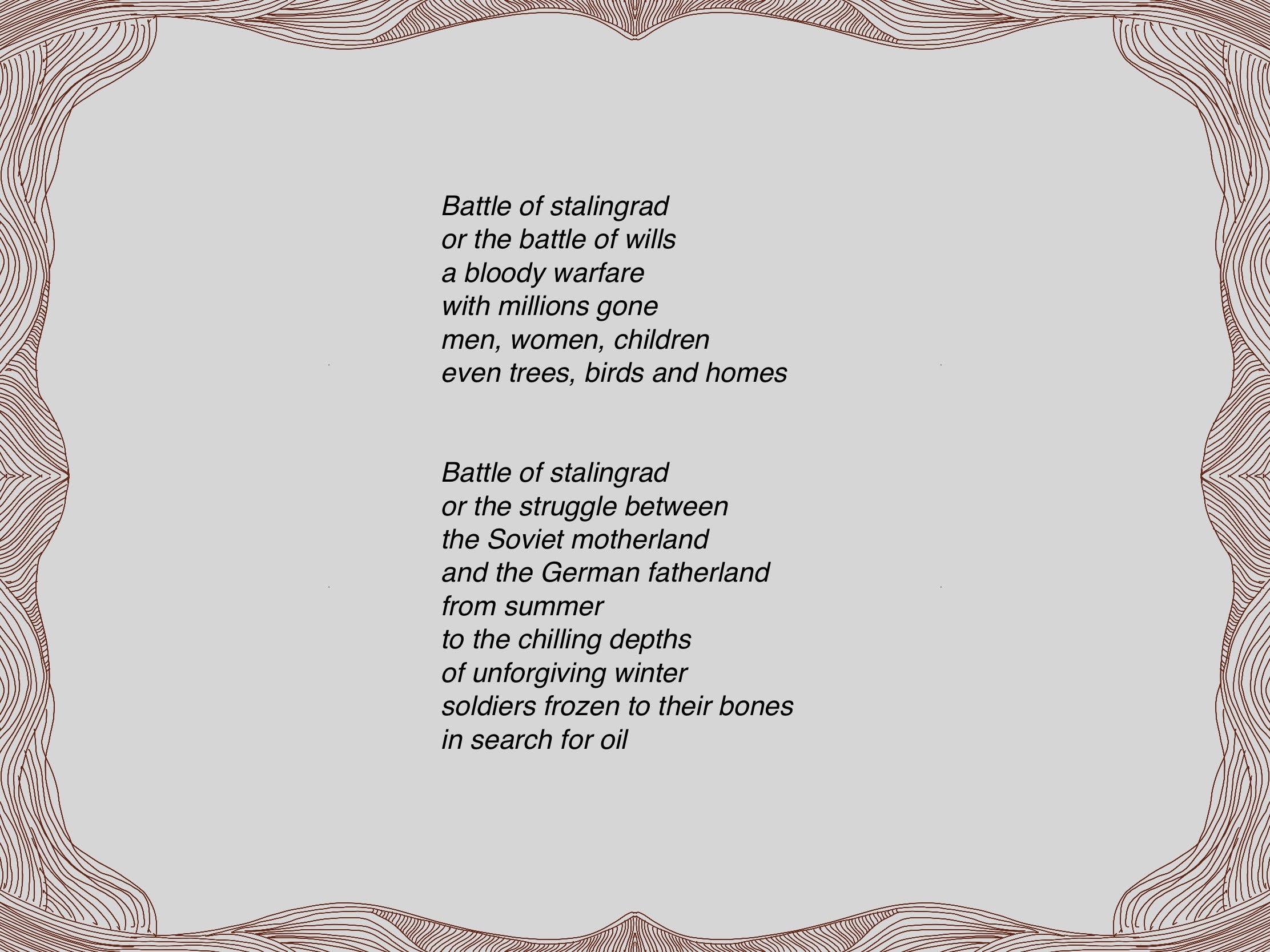
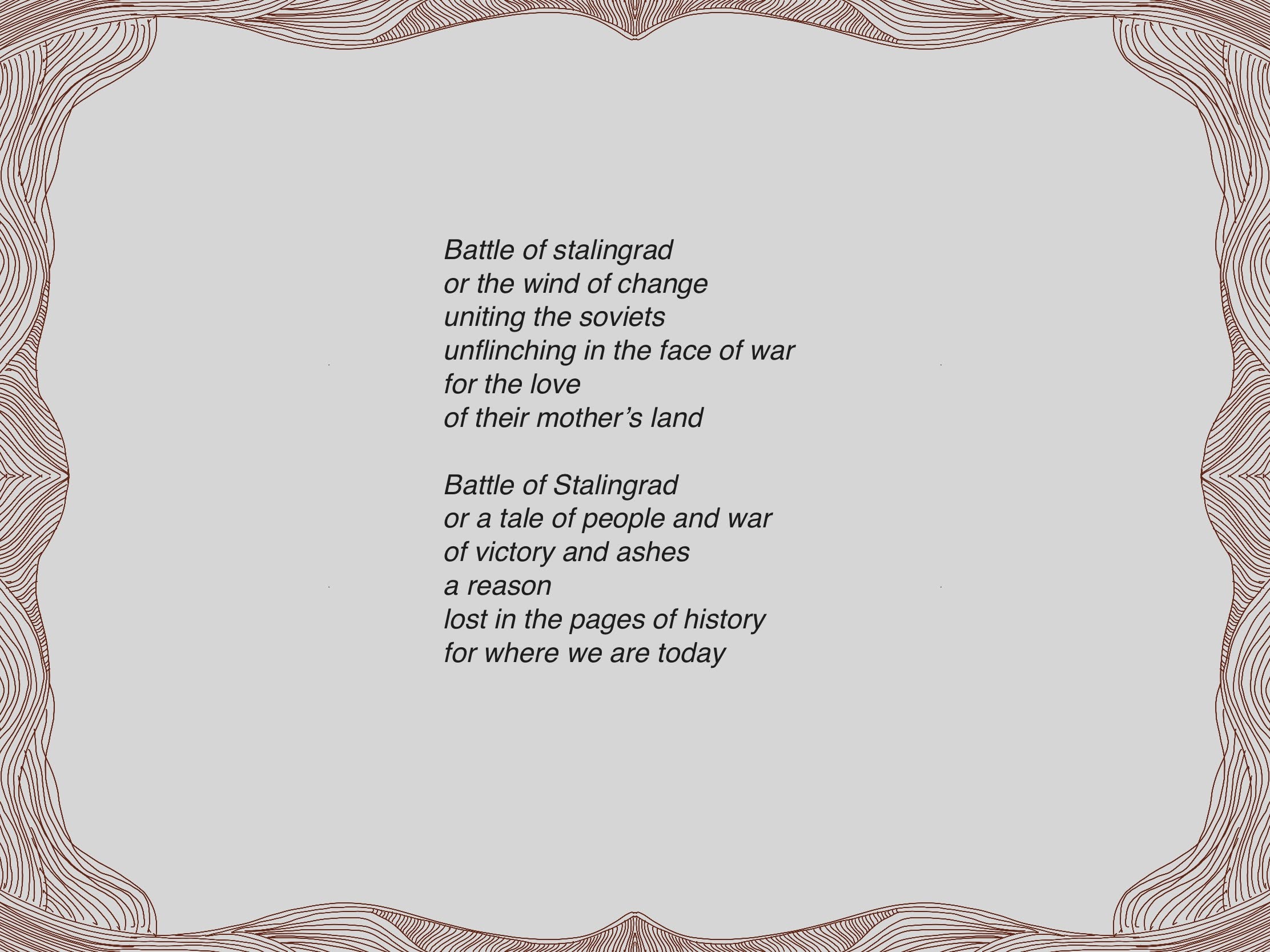
Stalingrad, now Volgograd, is a populous city in southwest Russia graced by the famous River Volga.
Perhaps, in its new name lies its renewal. For people to no longer be flooded by memories of war.

Before the skies turned black on Aug 23rd and Stalingrad was reduced to rubble, it was home to 850,000 people. Volga, the river was everywhere and it breathed life and joy into the lives of its people and around it homes were built for generations.
On bright summer mornings, couples would picnic by the Volga and by twilight elderly lovers, promenaded hand in hand spellbound by the river’s blue enigma. There were paintings, tapestries, stories, songs and poems about the Volga.
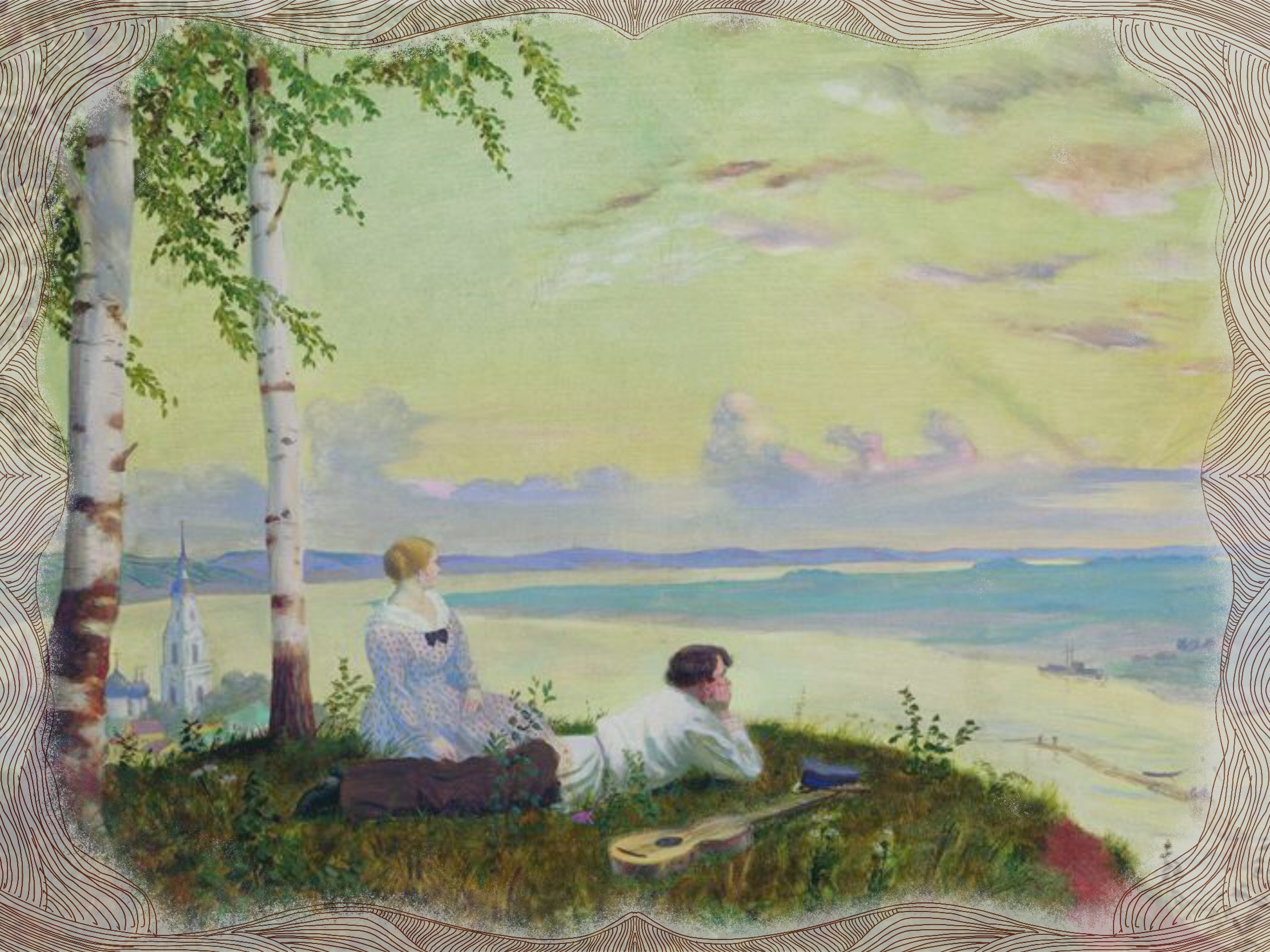
Volga’s presence was felt everywhere, every street, every lane, every market, the hill slopes, the balconies, the streets, the monuments, squares, parks, factories, little houses, apartment blocks all had their eyes turned towards it.
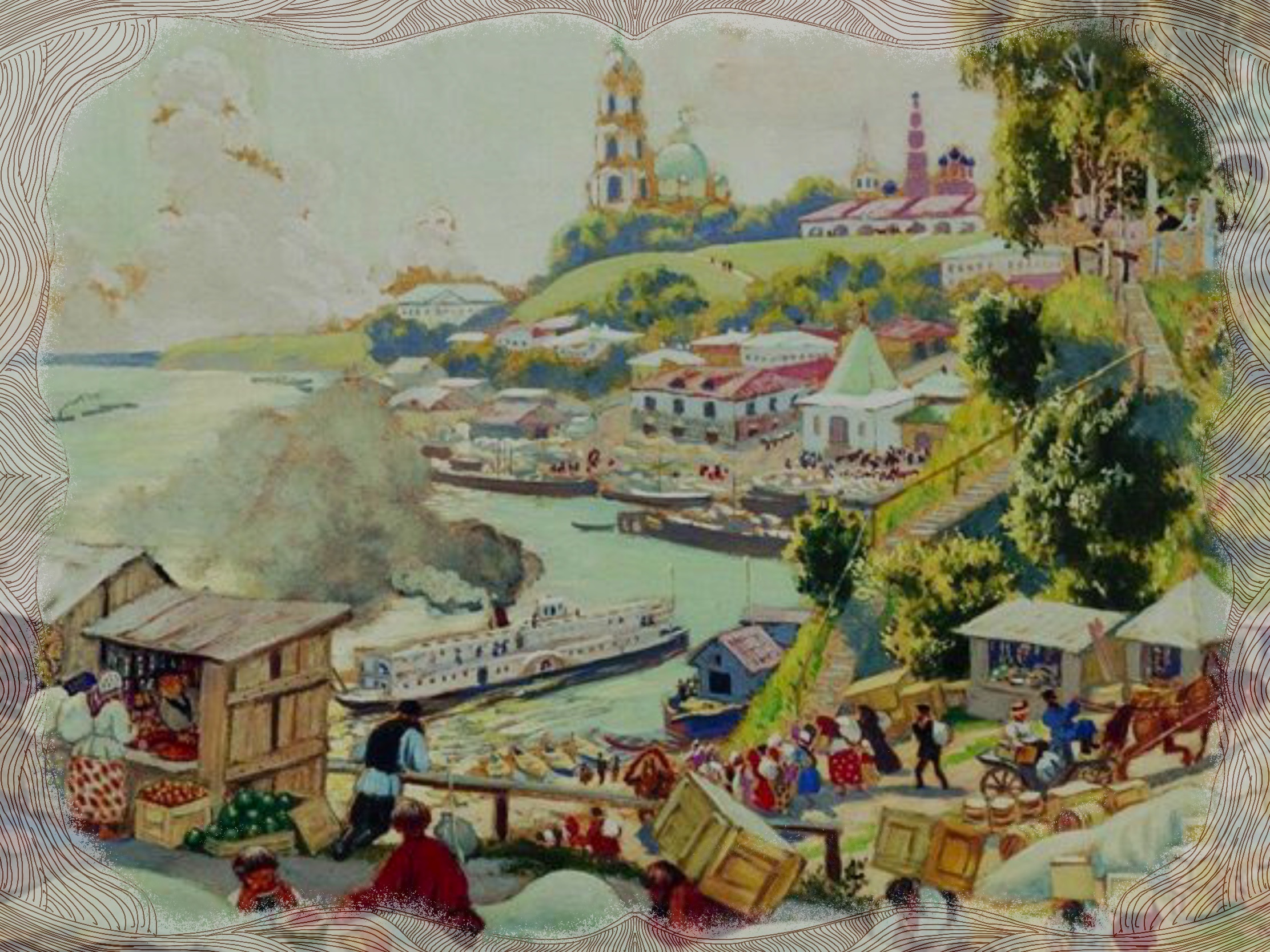
Ladies in white scarves and colorful skirts carrying ribbon umbrellas, children with happy smiles and men dressed daintily attended folk festivals on holidays by the markets all against the backdrop of the transparent blue Volga.
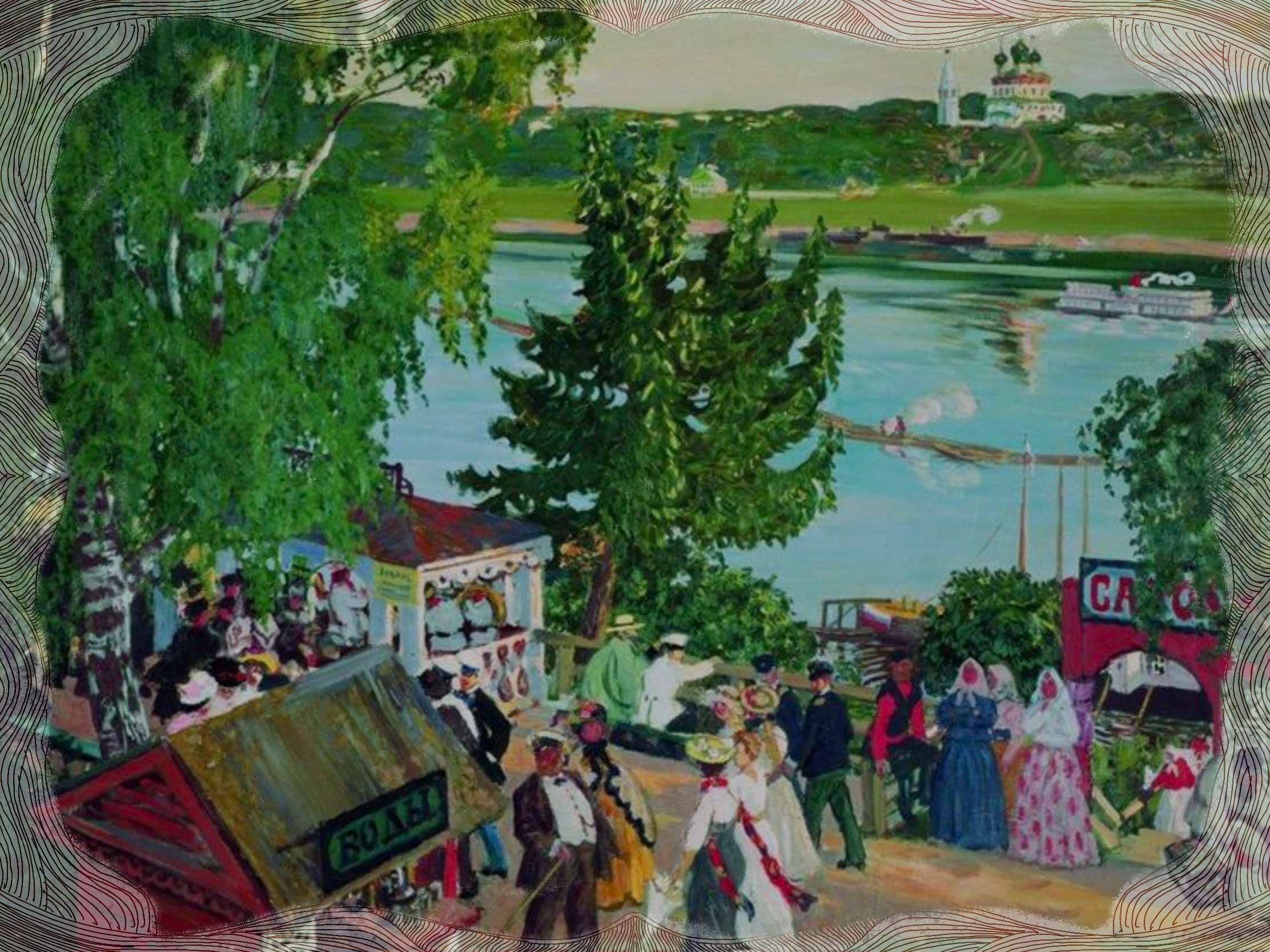
Paintings of Stalingrad and its Volga by Boris Kustodiev. Russian paintings are something else.
Life continued around the Volga, as the war relentlessly raged eastward. Children went to school, families visited the cinema, hawkers were going about their business on the streets, restaurants were open, families gathered over dinners to salute and bid goodbyes to the ones who were chosen to go into the army. The fate that was soon to befall their own city was known only to a few.
In the West, in summer of 1941, France was defeated and only Britain left standing.
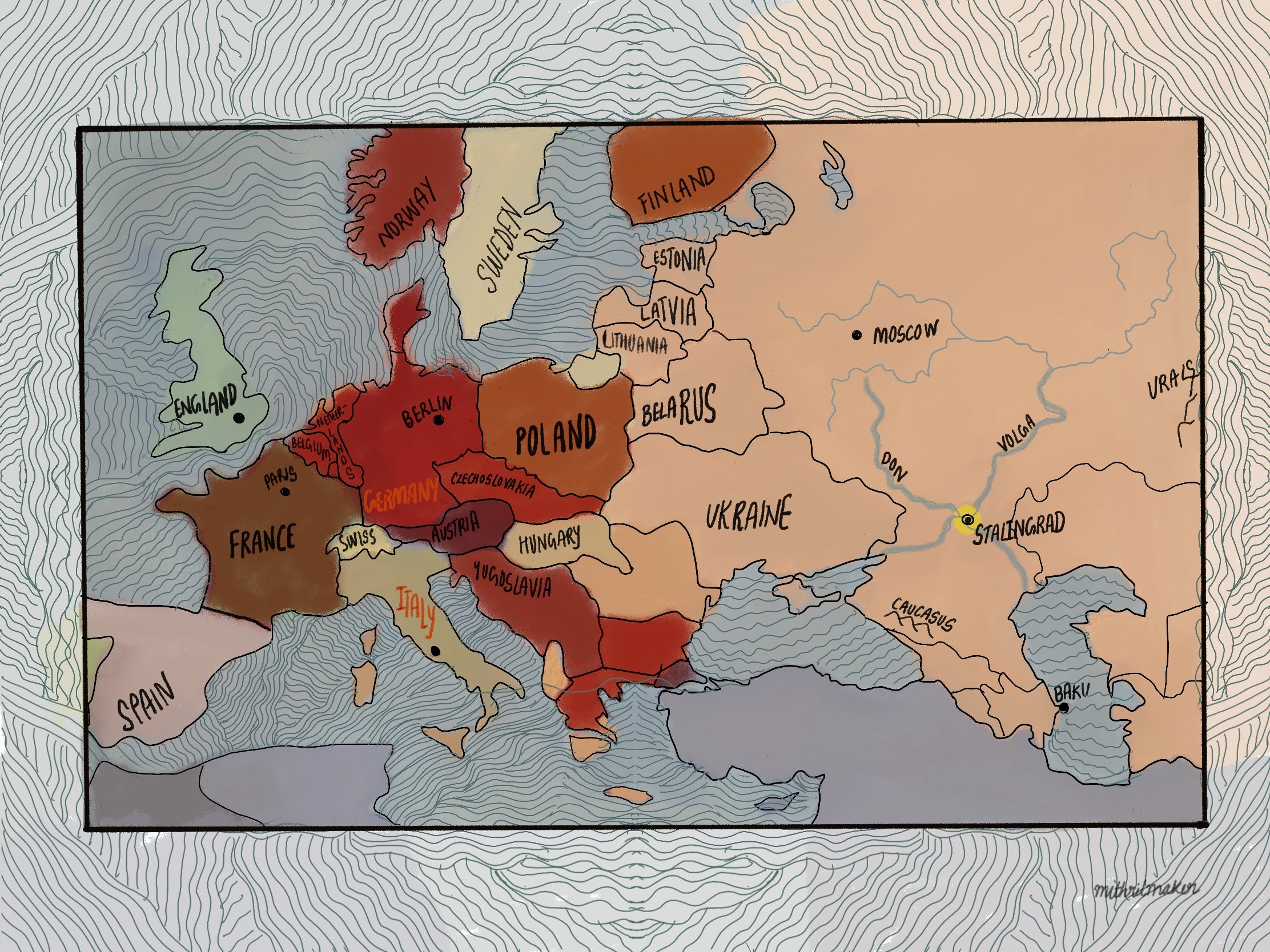
Everything in red had already fallen to the Germans and Axis powers.
Axis powers were headed by Germany, Italy, and Japan.
They opposed the Allied powers - grand alliance of Great Britain, the United States, and the Soviet Union- in World War II.
But Hitler wanted more. His ultimate goal - he writes in Mein Kampf - was Germany’s expansion to the East. This would ensure “Lebensraum” or living space and resources for the Germans.
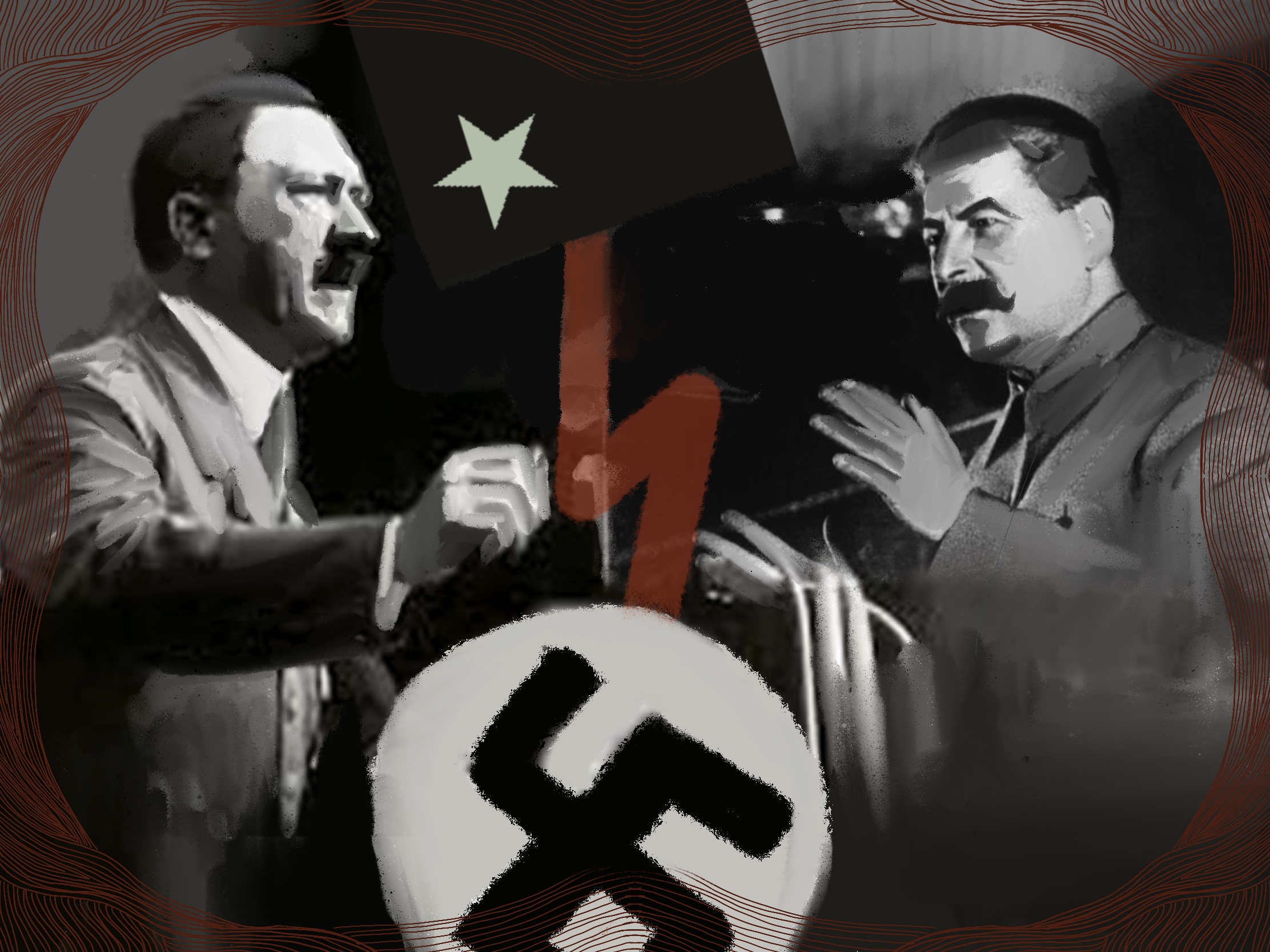
Hilter’s actions to overrule the Nazi-Soviet non-aggression pact made Stalin furious and the two countries became archenemies once AGAIN.
A non-aggression pact or neutrality pact is a treaty between two or more states or countries that includes a promise by the signatories not to engage in military action against each other.
On Sunday, 22 June 1941, the first surprise offensive was launched on the Soviet Union. It was called Operation Barbarossa. It opened up the Eastern Front of WW2.
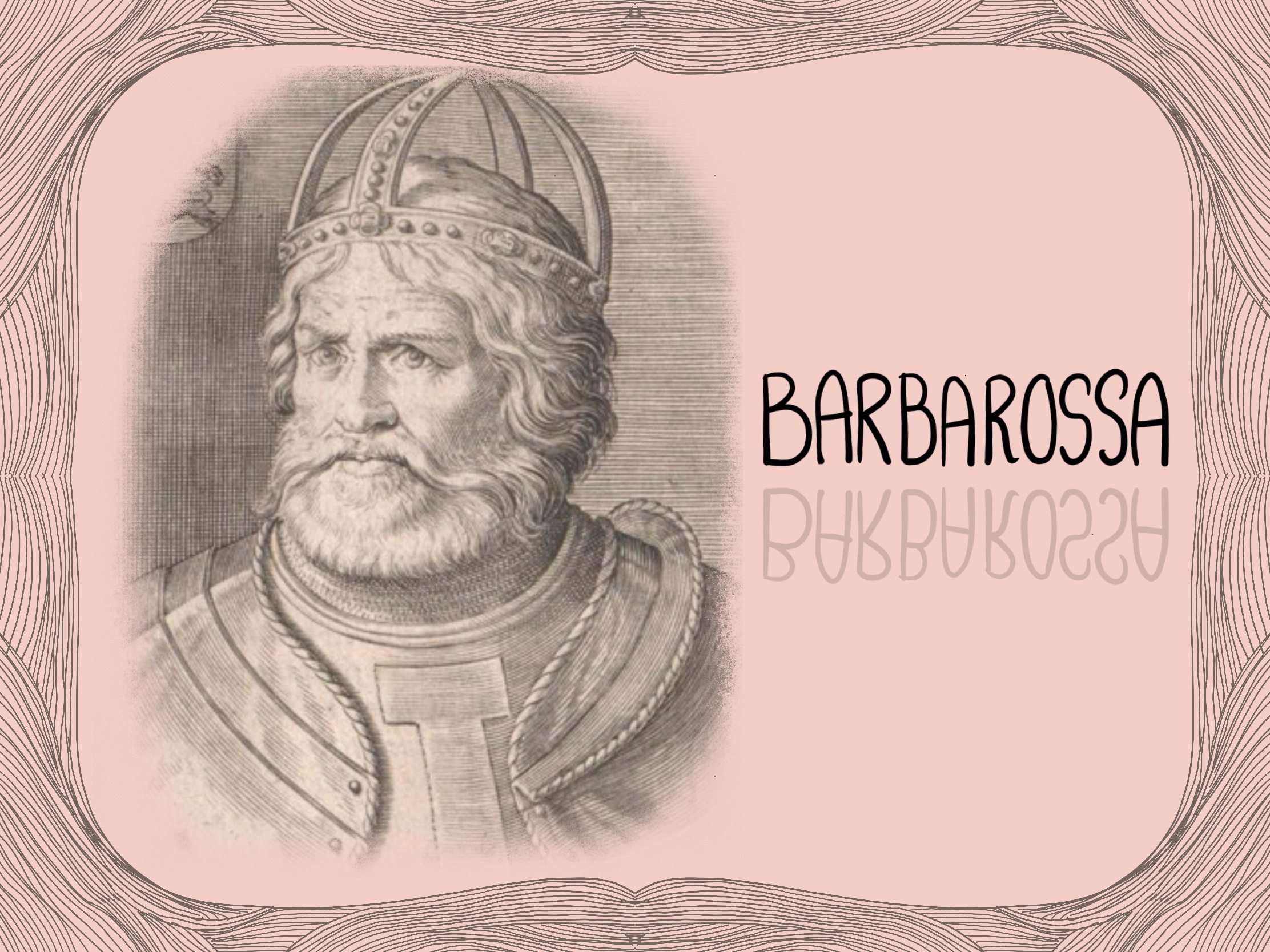
It was named after a renowned medieval King of Germany (and Roman emperor). Barbarossa means “red beard” in Italian.
The armies totalled over three million men and they were to advance in three geographical directions.
Army Group North’s objective was Leningrad via the Baltic states.
Army Group Centre’s objective was Smolensk via Minsk.
Army Group South (which included the 6th army) was to take Ukraine via Galicia.
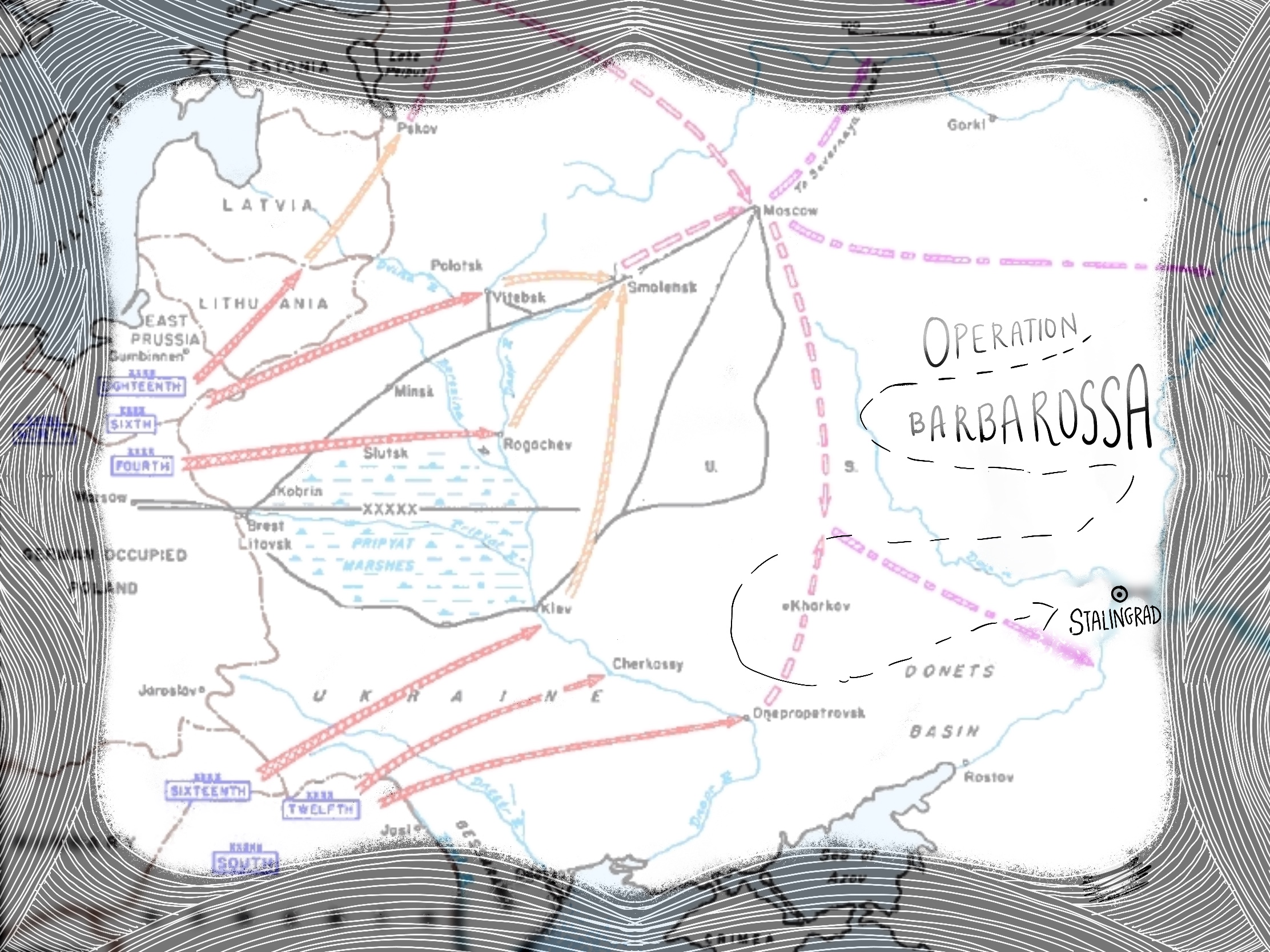
The original Plan made by Commander Erich Marcks.
Operation Barbarossa lasted for 5 months. 22 June 1941 – 5 December 1941
However, it led to a domino effect where subsequent battles were trigered one after another. Here’s to name a few :
Battle of Kiev 23 August 1941 – 26 September 1941 | Battle of Białystok–Minsk 22 June 1941 – 9 July 1941 | Battle of Moscow 2 October 1941 – 7 January 1942 | Siege of Leningrad 8 September 1941 – 27 January 1944 | Battle of the Sea of Azov 26 September 1941 – 11 October 1941 | Battle of Rostov 17 November–2 December 1941 | First Battle of Kharkov 20–24 October 1941 |
and many more including
Battle of Stalingrad Aug 23, 1942 – Feb 2, 1943
All these battles happen as a consequence of opening an eastern front in 1941 with Operation Barbarossa.
Army Group South is the one we are interested in.
As a continuation of Barbarossa, the Army Group South began Operation Blau (or Case Blue) which involved a two pronged attack on Soviet territory. Two groups or Heeresgruppe A and B were created and they were tasked to do different things.
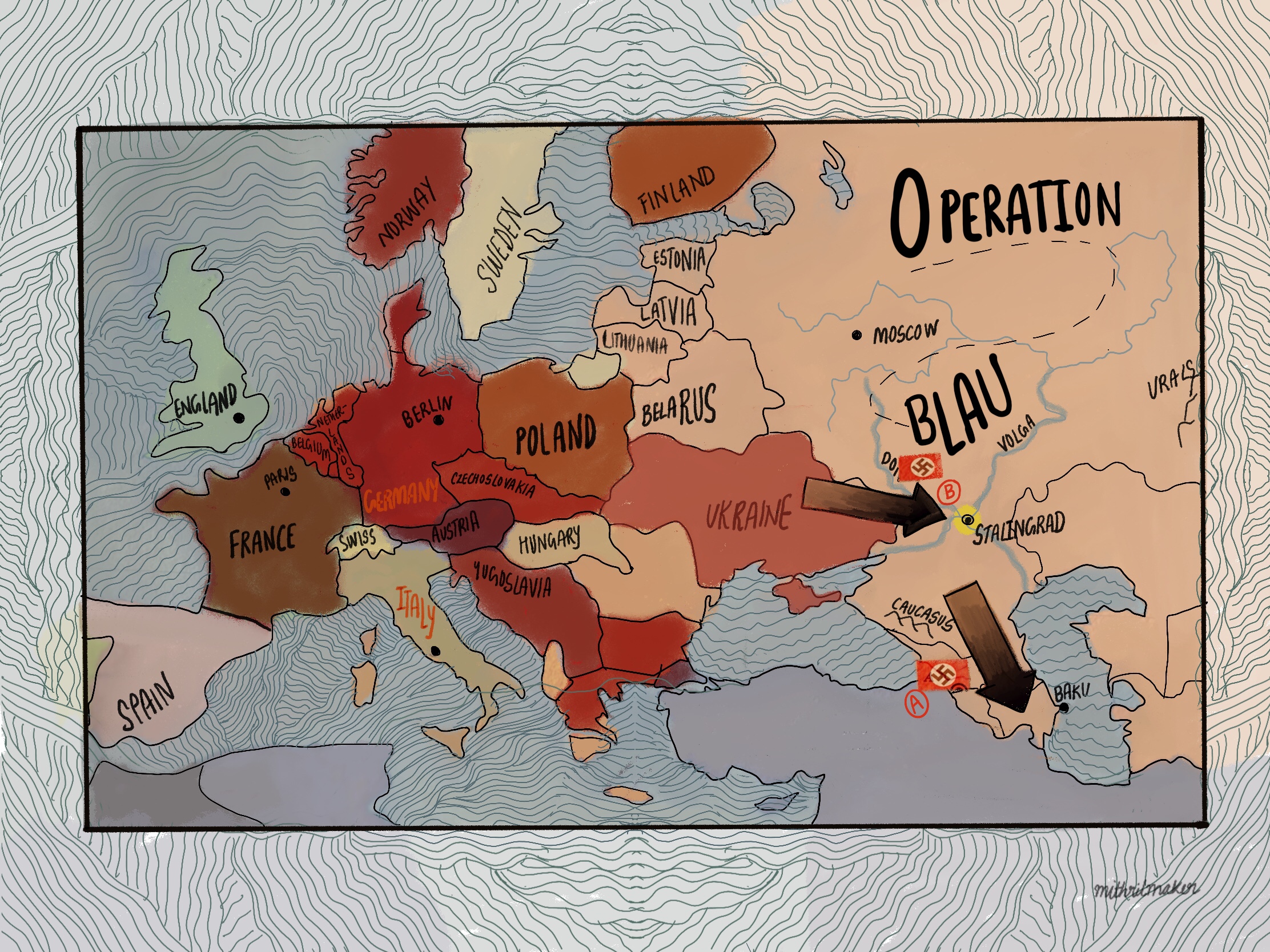
Army Group A was to cross the Caucasus mountains to reach oil fields in Baku and Azerbaijan.
And Army Group B was tasked to protect the northern flank of A and capture Stalingrad. Stalingrad was a major industrial and transport hub on the Volga River that ensured the Soviet Army’s access to the Caucasus oil wells to keep their armies fueled.
Army Group South (B), includes Friedrich Paulus’s 6th Army and Hermann Hoth’s 4th Panzer Army.
Hitler badly wanted Stalingrad to fall. It was mean’t to be an intentional attack on Stalin’s psyche. Note how Stalingrad has Stalin’s name. Germans were riding a wave of confidence. Stalin had to stop them at any cost. He had to inspire people like never before. He initiated a scorched-earth policy to deny the Germans and their allies basic supplies. So people started burning their homes, farms, fields, anything that could be useful to the Germans and were left to their own devices to migrate eastward. The Russians knew what the Germans were doing to the jews and to the nations that had fallen.
Who is to say if it was the words of a dictator or the love for their motherland and hatred for the invaders that enabled them to unfathomable heights?
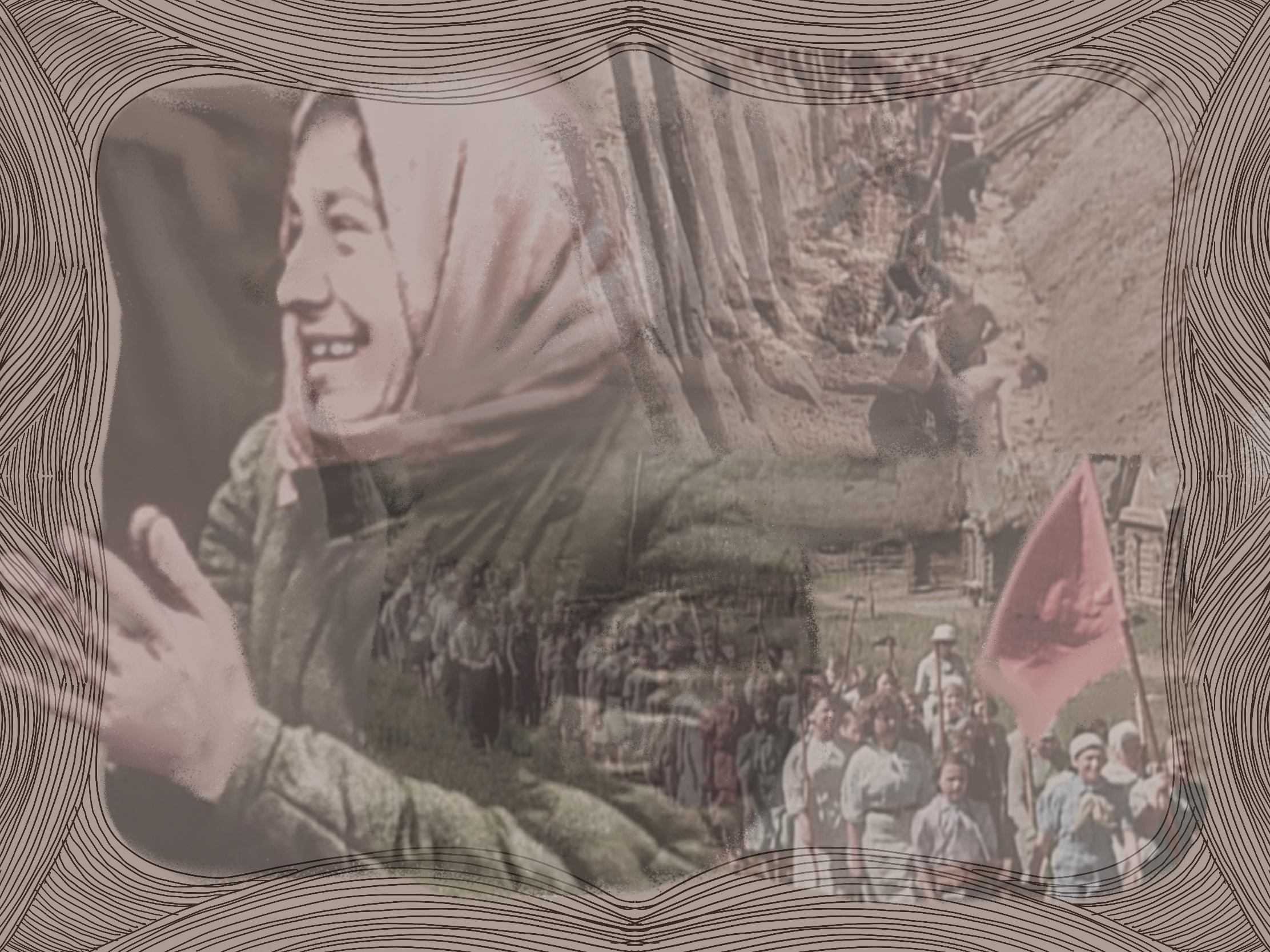
Men, women and children prepared for a ground attack by digging anti-tank trenches, setting fire to their homes and farms. Army Group B was expected to arrive at any moment. However, they were constantly delayed by Russian counterattacks and overstretched supply lines. But the 6th Army finally reached the outskirts of Stalingrad on 23rd August, 1941.
These delays would cost the Germans more than they could have imagined.
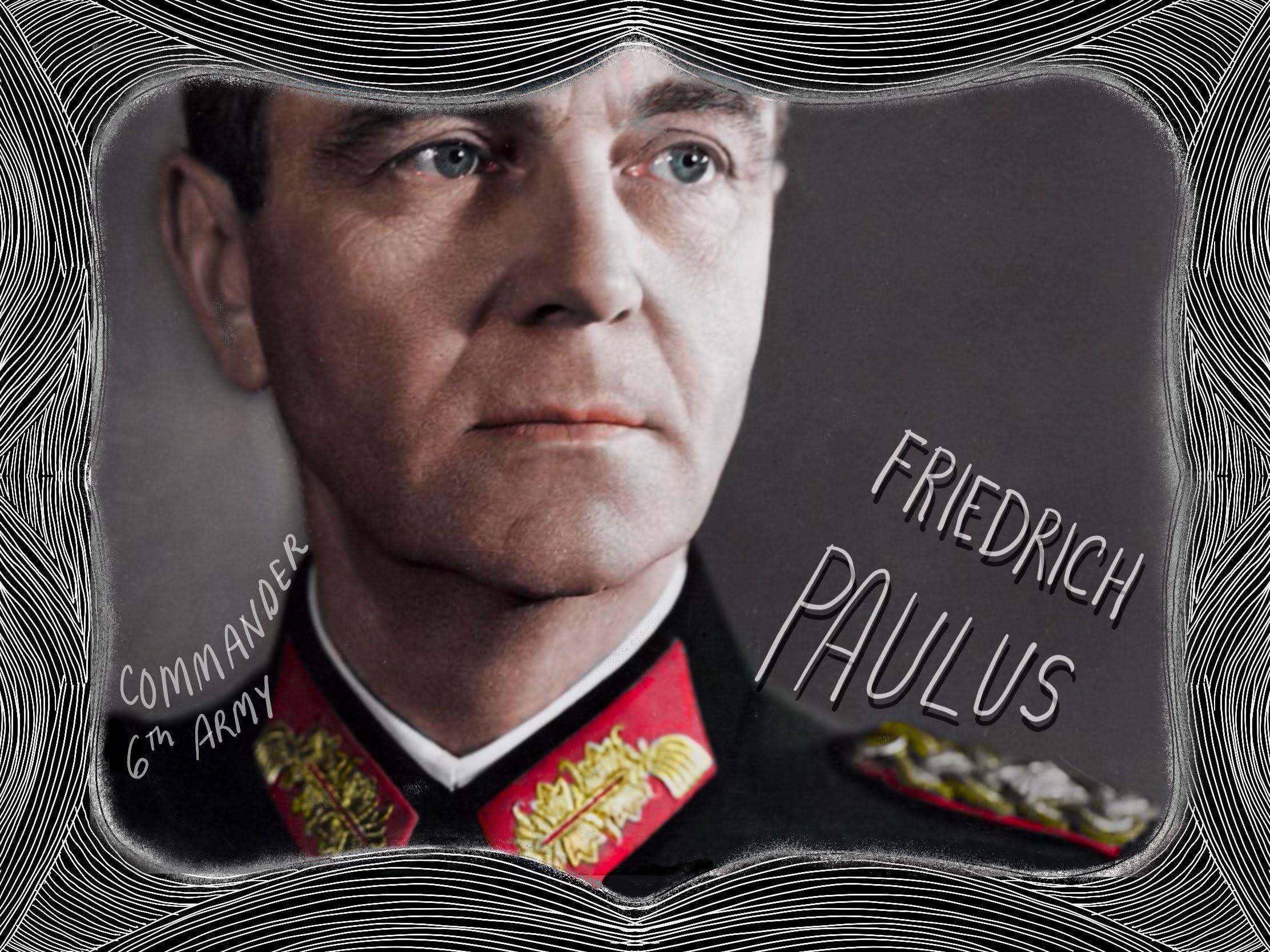
Friedrich Paulus was the Commander who lead the charge on the German side. His experience lied in using long range weaponry to intimidate his opponents. And so on the same day, the attack came not from the artillery but the air. Residents were walking to work and school when they were bombed. The Luftwaffe obliterated most of the city as the Soviet air force was no match for it. The landscape turned apocalyptic. The Russian airforce was no match for the Luftwaffe. So within minutes everything was gone.
Luftwaffe was the official name for the German air force
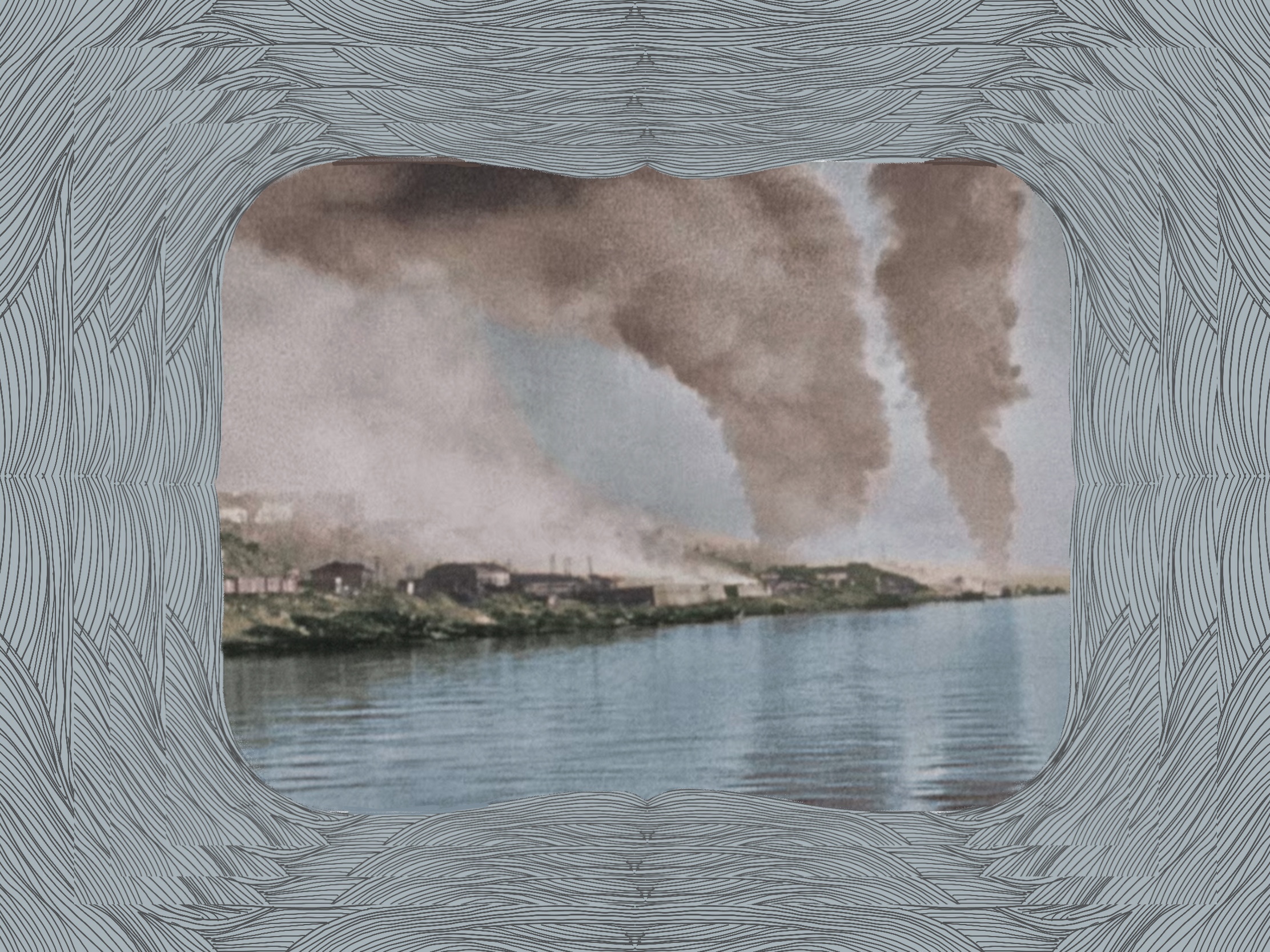
The city went up like a funeral pyre. The blue Volga and the blue skies were dark with pillars of smoke that went on for months.
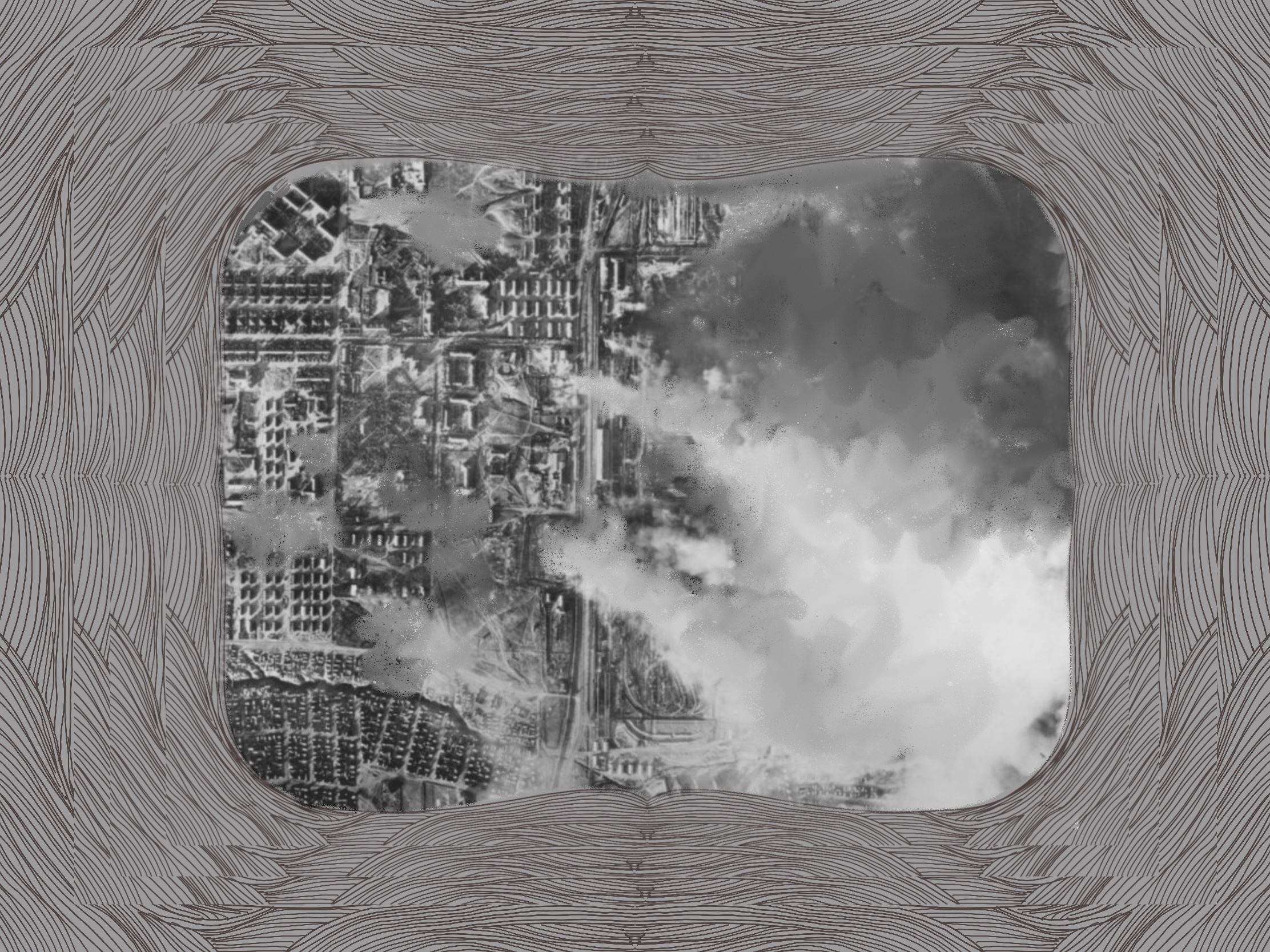
Neat city blocks converted into nothing but piles of steel and stone

40,000 soviets died. But Stalin’s mandate continued.
“All survivors will not take a step back. You have to stay and fight.”
“There is no land for us behind the Volga.”
Became the battle cry for the Soviet (Red) Army.
If Stalingrad fell, it was The End for the Soviets. So everyone fought. Including the Women.
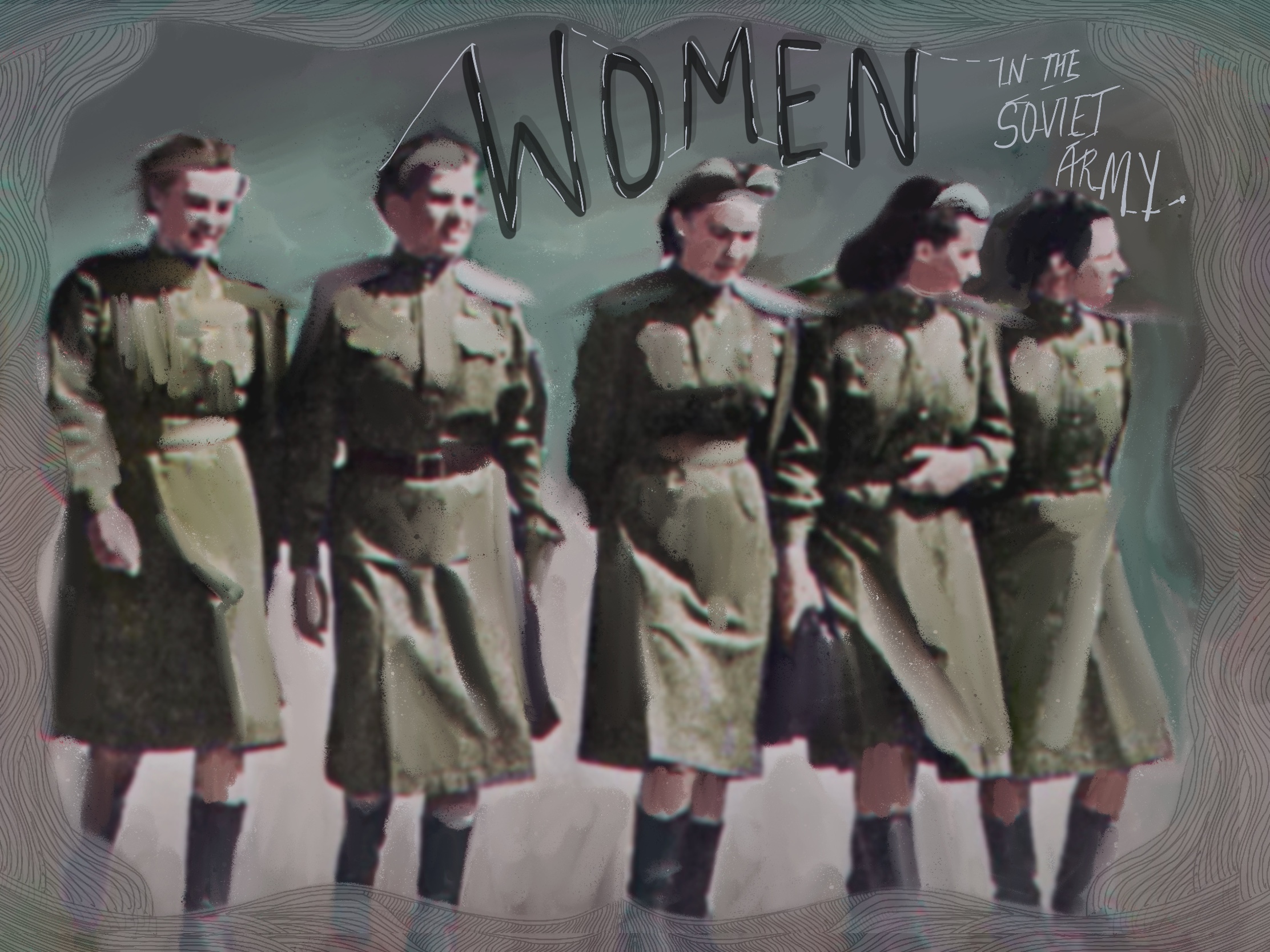
About 1 million soviet women were conscripted in the Red Army. Almost in the same proportion as men. They were gunners, snipers, nurses and medics. They went to the battlefied. There were no women in the German army. So when the Germans encountered women, they were stunned. Women in Germany were mothers and homemakers not combat soldiers. The Germans blamed Soviet communism for this.
Among many roles that women played during the war, being snipers was one they were really good at. For the skill required precision and immense patience. The urban warfare that Stalingrad witnessed emphasized the importance of the Sniper’s ability to take down an opponent surrounded by rubble with surprise.
Among celebrated Soviet snipers was Vasily Zaitsev. In the Battle of Stalingrad, he killed 225 enemy soldiers, of which 11 were snipers. The famous hollywood movie Enemy at the Gates starring Jude Law was based on his story.
Despite the superior airforce and gains, German advance was no more than several meters a day. Moving the artillery and tanks had proved difficult since much of the city had been reduced to rubble. Not only was Paulus recently promoted to lead the 6th army but he was offered very little in the way of mentorship from his superiors. He had to change his tactics. The army made strategic gains by taking the high ground at Mamaev Kurgan for surveillance and they cut off soviet supply lines to industries and railways.

Soviets send the 62nd Army under the command of General Vasily Chuikov to stop the Germans. Chuikov was an experienced general who was one step ahead of this German counterparts. He knew they needed mobility and space but his army would deny them that.
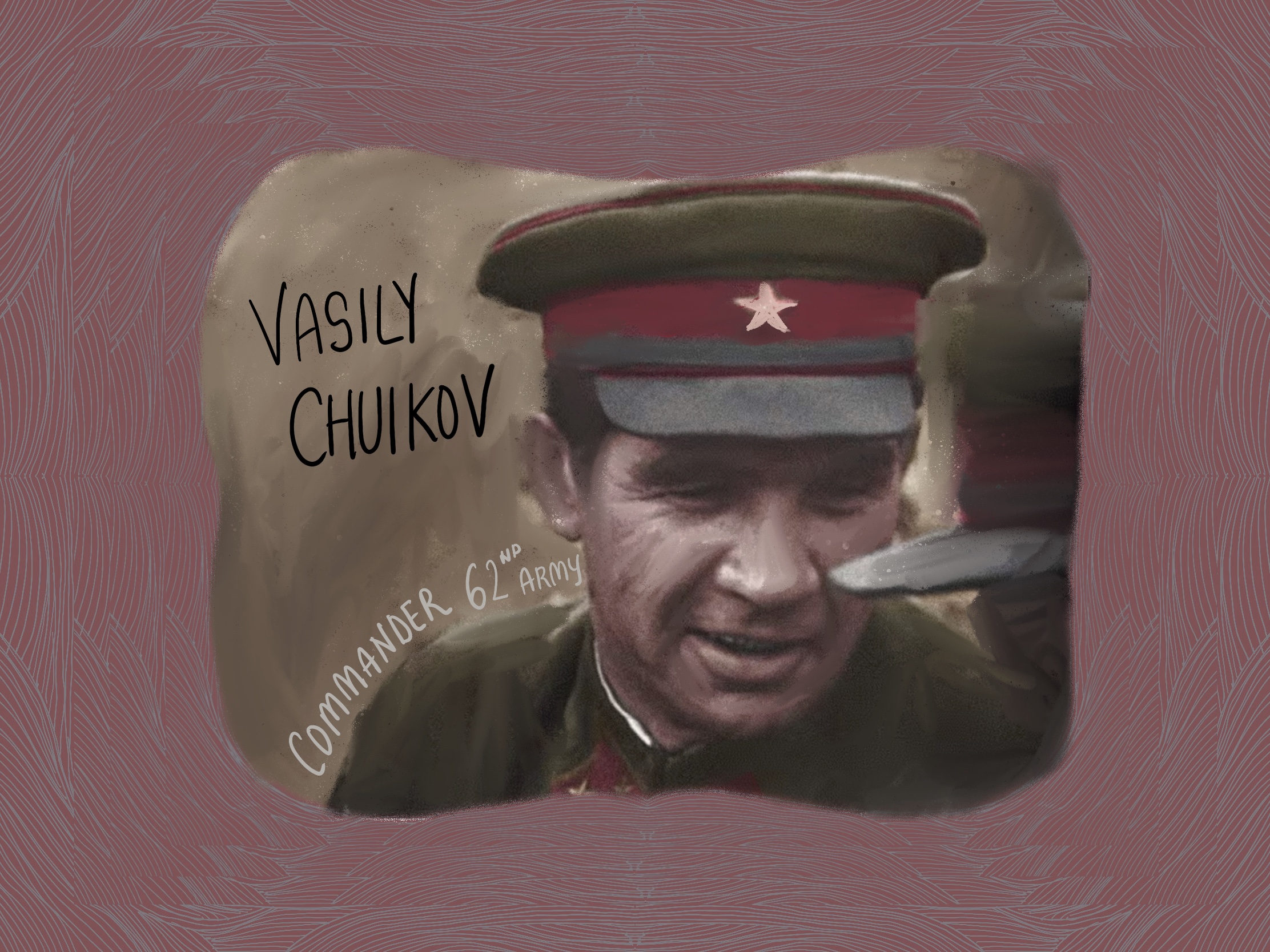
The Russian army adapted the Stormtroop or hug the enemy tactic where soldiers would be no more than a grenade throw apart. Paulus’s plan to use airpower and artillery would be rendered useless to avoid risking his own troops. The war turned from Blitzkrieg to Rattenkrieg (rats war/dirty war)
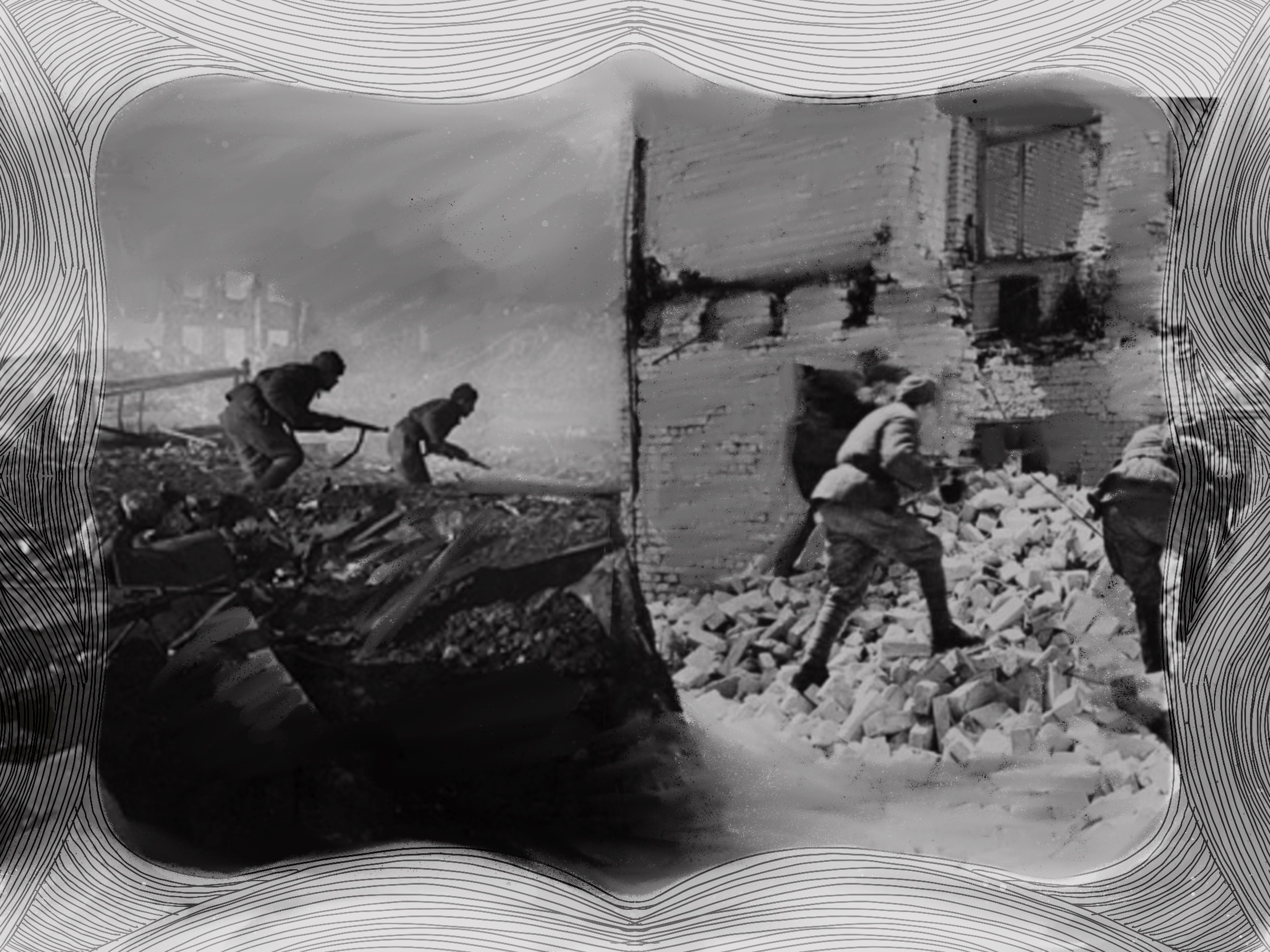
The soldiers fought at close proximity. Living and advancing through shattered landscapes.
Inspite of this, the Germans were doing well. They had taken back the defenders to a narrow strip before the volga and to Hilter it looked like the battle was already won. Chuikov had just enough soldiers to keep the Germans at bay.

Germans had advanced almost all the way.
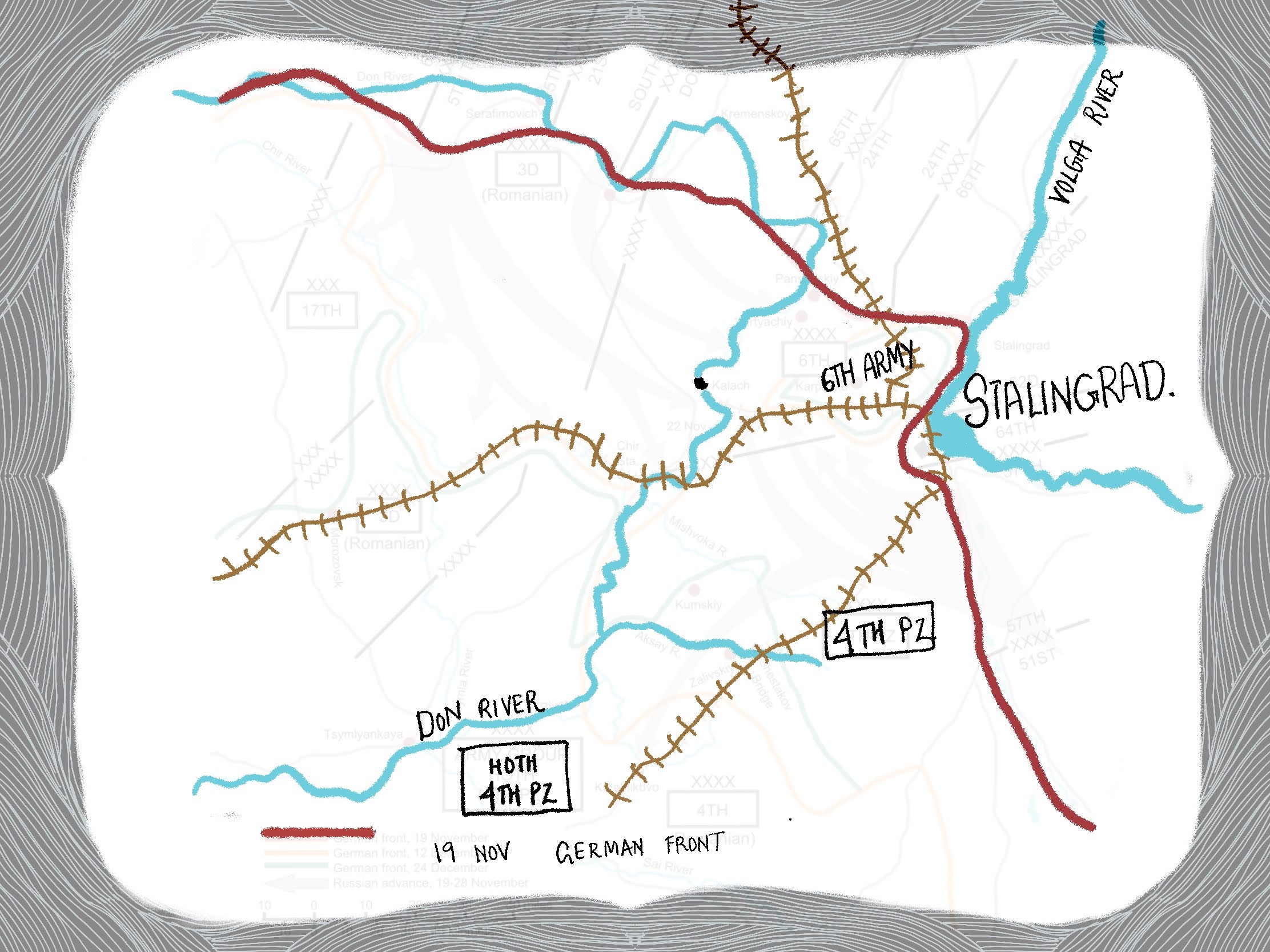
On Nov 19th 1941, the German Army front line was at Volga.
The Russian winter was closing in and the pace of the battle had slowed. The German army began to run short of supplies. With the surroundings scorched, nothing useful was found. The 6th Army had not completely eliminated the remaining Soviet troops.
The Germans were so close to crossing the Volga and taking Stalingrad. But on Nov 19th 1941, the Soviet resistance holds out and the War changes .
Soviets launched Operation Uranus. A major offensive on the flanks(sides) of the German Army.
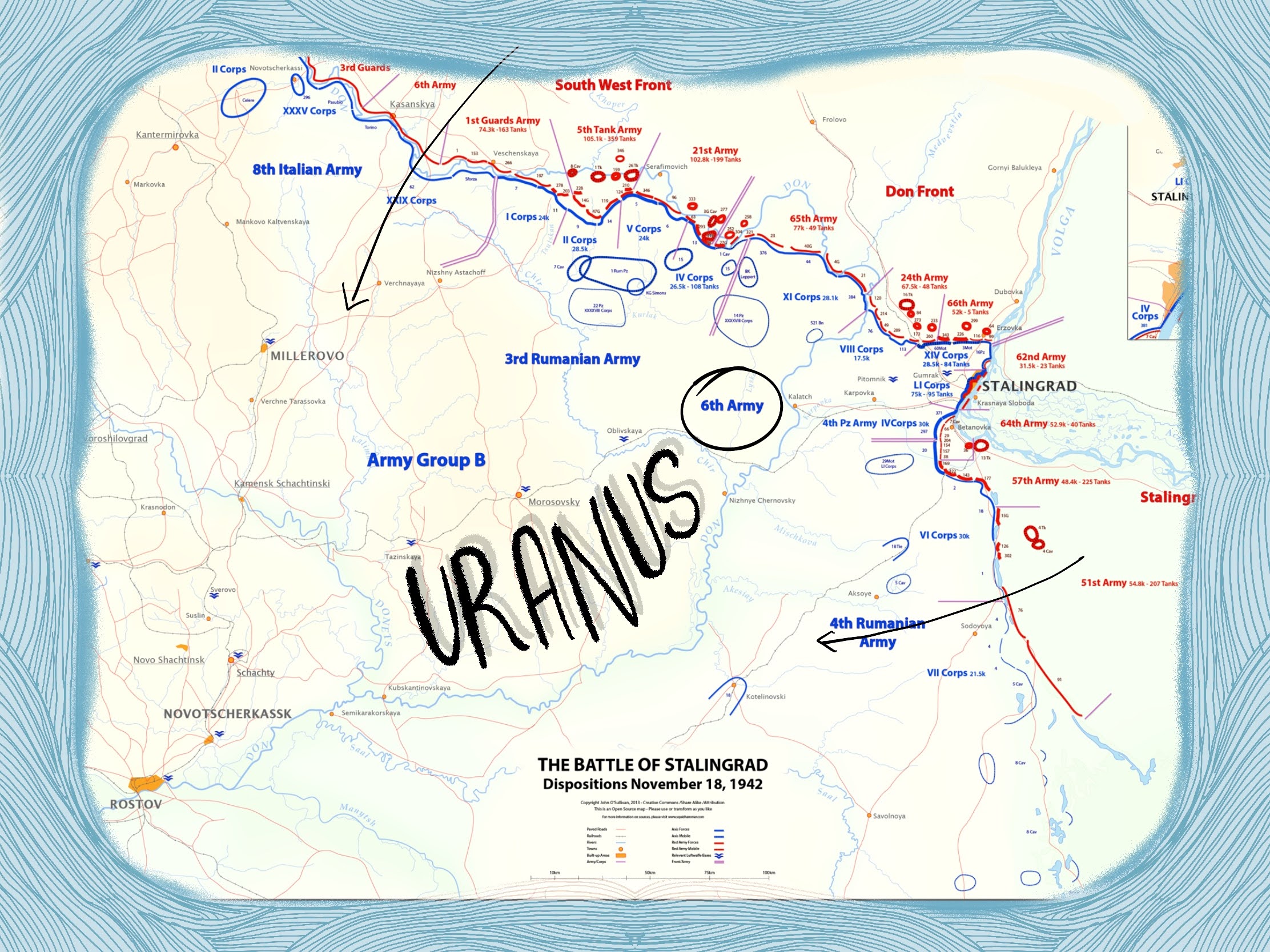
German intelligence service never expected the Soviets to be capable of a counter-attack. Stalingrad revealed the absolute limits of German logistics.
There is no plan B.
So when the attack happens the Germans are shocked and paralysed. The offensive was being planned since September and the Germans were duped on a grand scale.
The Russians tactically attacked the northern and southern flanks. On these flanks were fighters from affiliated armies- Italians, Romanians, Hungarians who were easier to take out. These armies had no intention of fighting through the depths of the Russian winter. The cream of the German army, 6th army, was concentrated upfront.
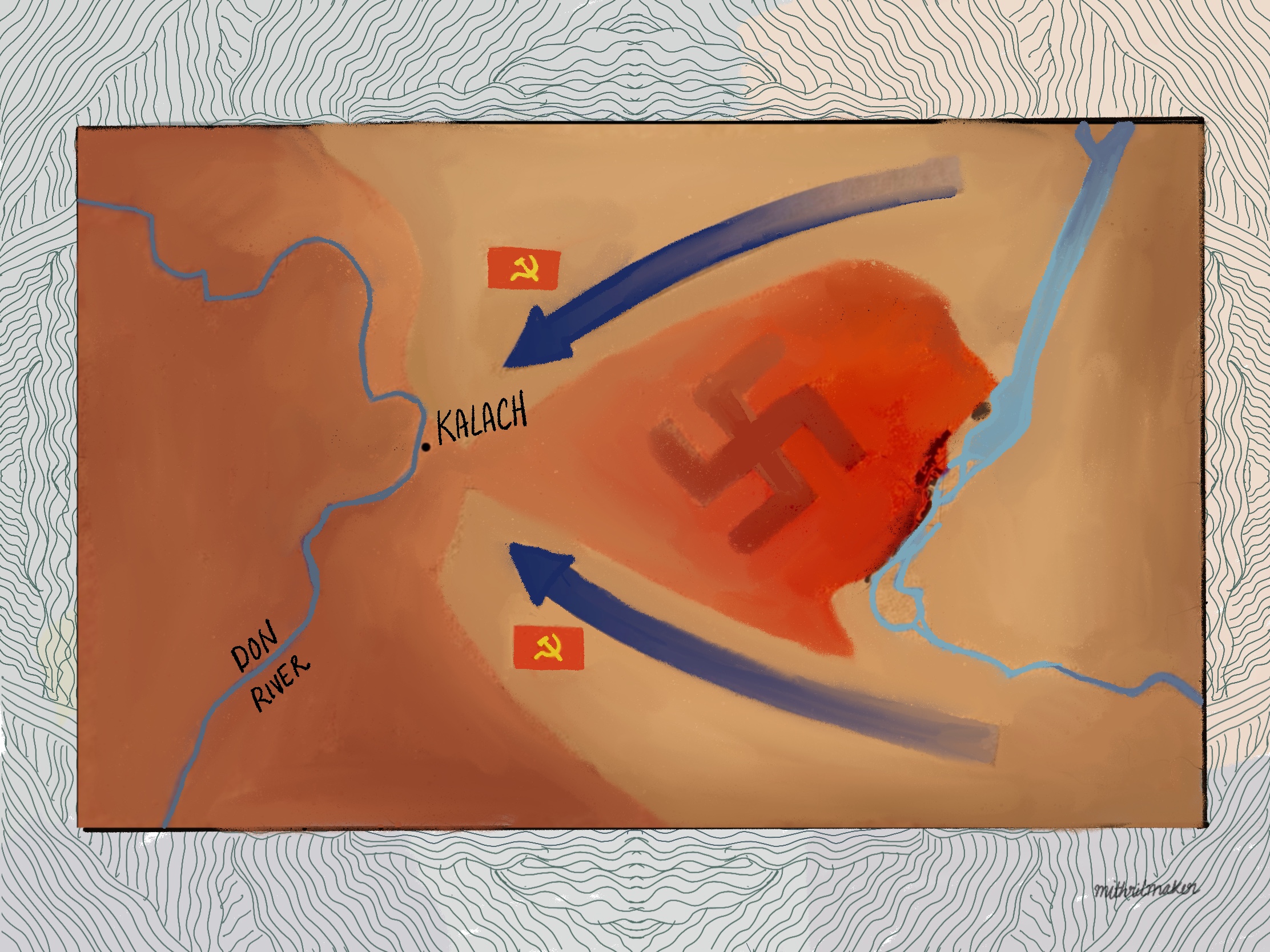
On 23 November, just five days later the pincers met at Kalach-na-Donu, thereby encircling the German 6th Army, the Romanian army, and portions of the German 4th Panzer Army. 300,000 soldiers were in the kessel.
But Hilter would not accept defeat at any cost. So Paulus obeys him and in his own words justifies his actions:
“What would become of the war if our army in the Caucasus were also surrounded? That danger is real. But as long as we keep on fighting, the Red Army has to remain here. They need these forces for a big offensive against Army Group ‘A’ in the Caucasus… We must hold them here to the last so that the eastern front can be stabilized. Only if that happens is there a chance of the war going well for Germany.”
By the end of November it is clear that the army will not survive without any food and supplies. Goering, the airforce lead, feeds Hitler’s delusion of Victory. He suggests that his Luftwaffe can supply the trapped army with fuel and food. So when the German aircrafts arrive to relieve their soldiers they are blocked by the Red Army. The effort is a massive failure.
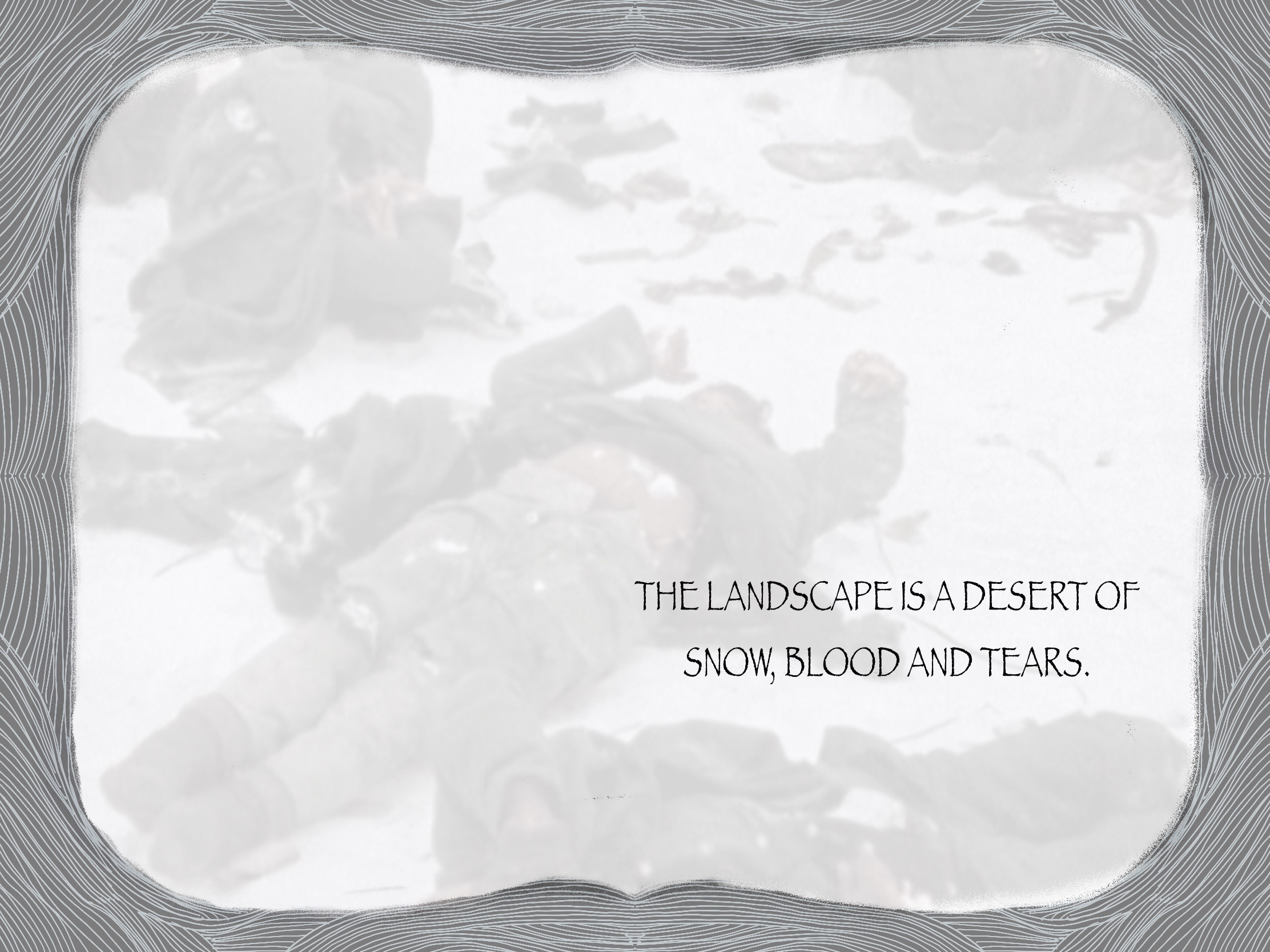
Only solution left is for the army to breakout. Another relief effort is prepared: Operation Winter Storm. Lead by Erich von Manstein, the German 4th Panzer Army is tasked to break the Soviet encirclement of the German 6th Army.
By Dec 13th December, the Germans advance considerably.
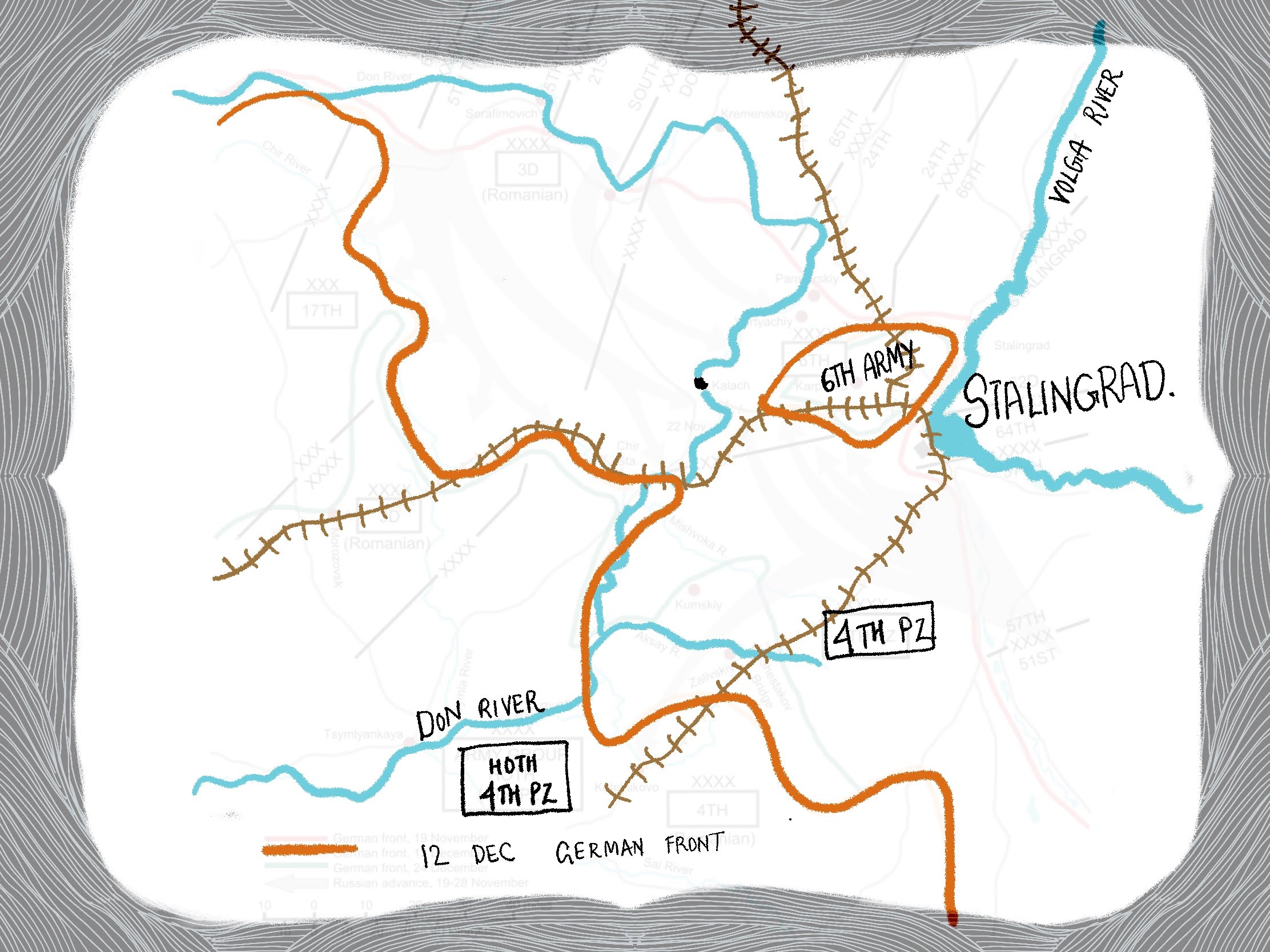
However, by 24th December, Manstein’s efforts are squashed by another Russian counter-offensive (Operation little Saturn) and the 4th panzer German army retreat. Another missed opportunity. The Red Army continues the “strangulation” of German forces in Stalingrad.
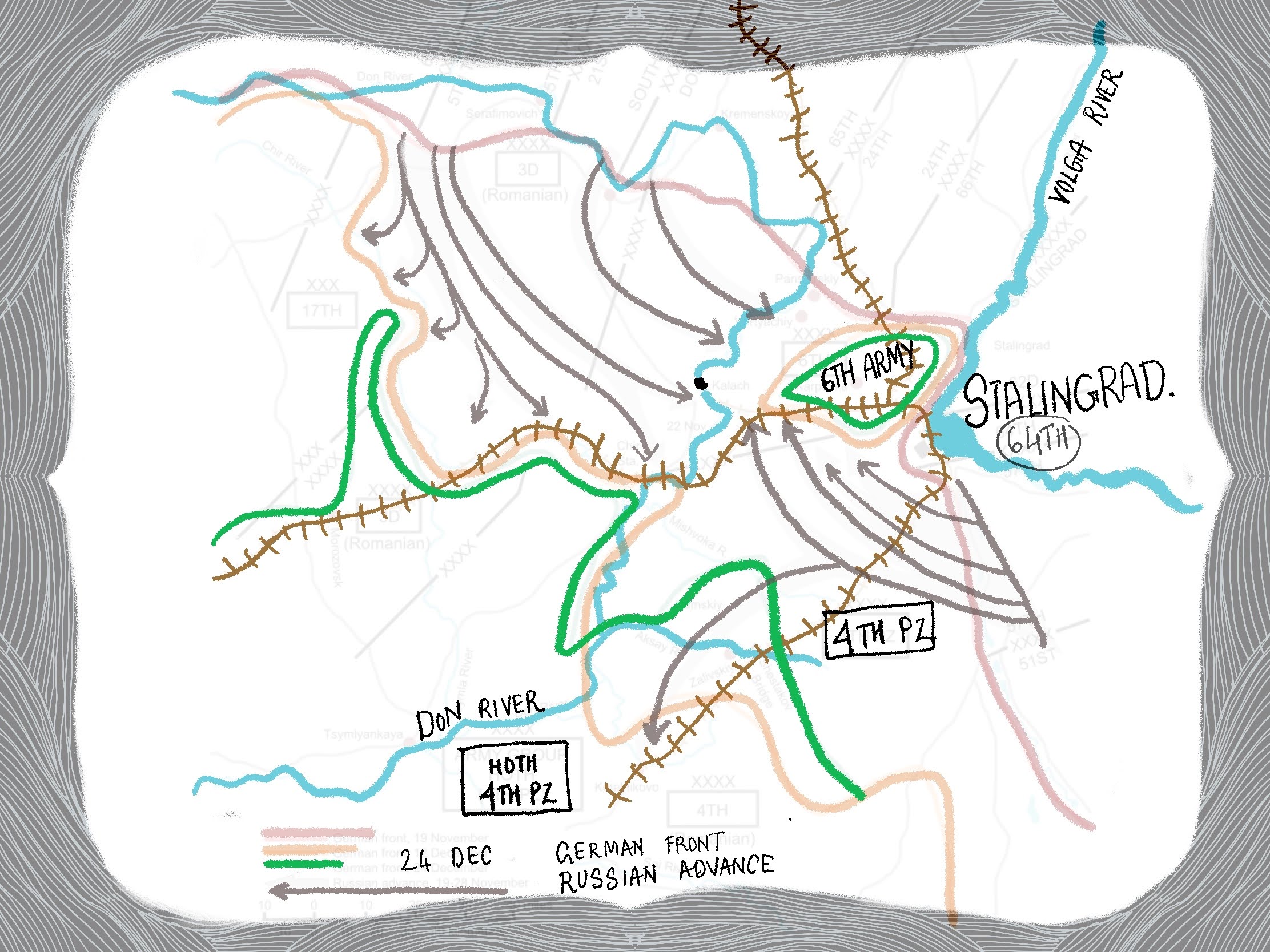
When the new year dawns (1942), the Red army offer the Germans a way out. Surrender.
Paulus wanted to surrender. But his requests are denied by both Hitler and Manstien. Soviets take stricter measures and continue to strangulate the kessel. German resistance is non-existent. Red army forces the Germans in two small pockets that lose contact with each other.
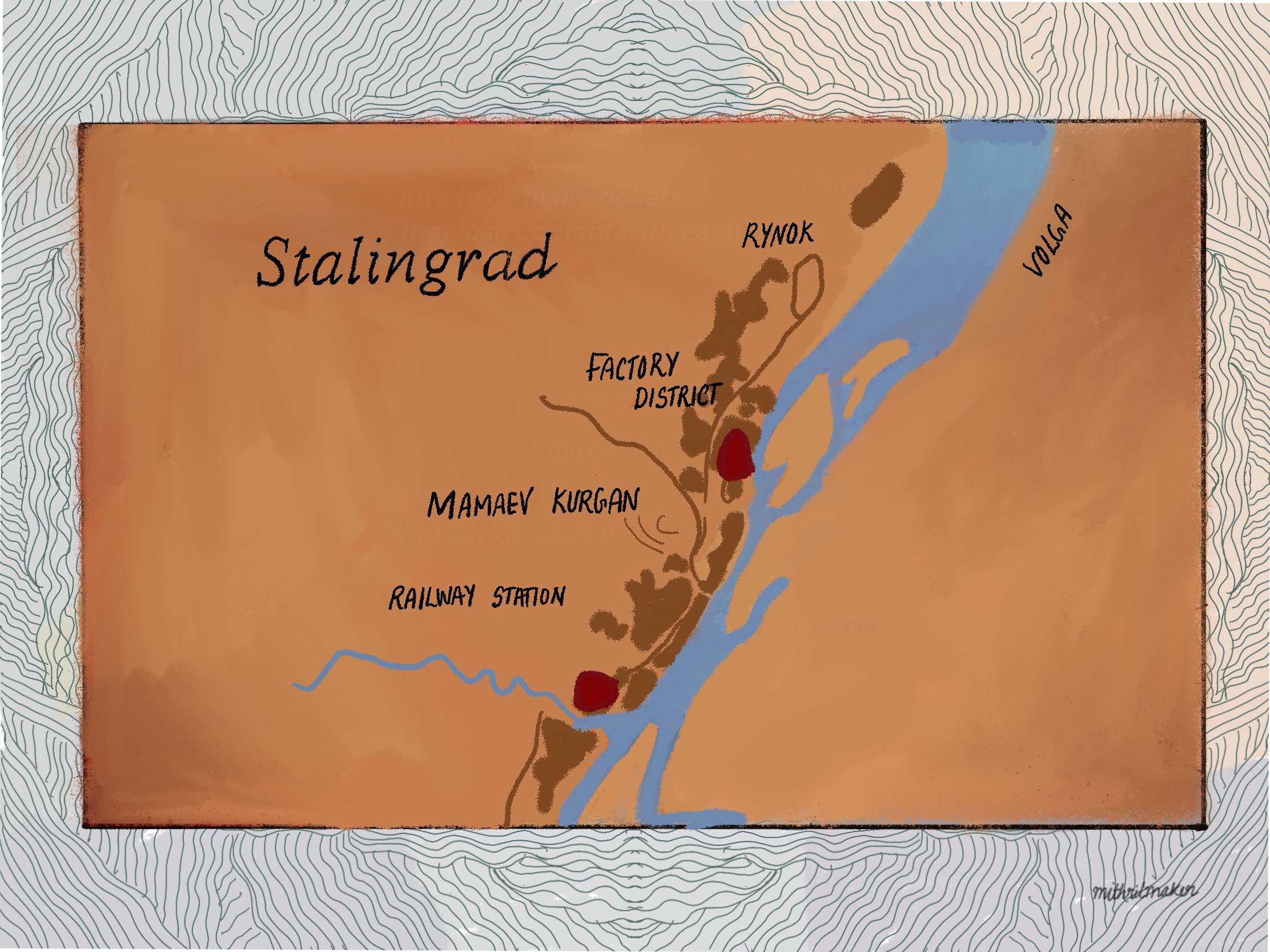
On Jan 30th 1942, Hitler promotes Paulus, and the honor carries an ominous message - die but you cannot surrender. Paulus was a Roman Catholic and was opposed to suicide. Paulus sent his wedding ring back to his wife on the last plane departing his position. He had not seen her since 1942 and would never see her again.
Finally Paulus disobeys Hitler and surrenders to the Red Army.
From the personal diary of one of Paulus’s aides :
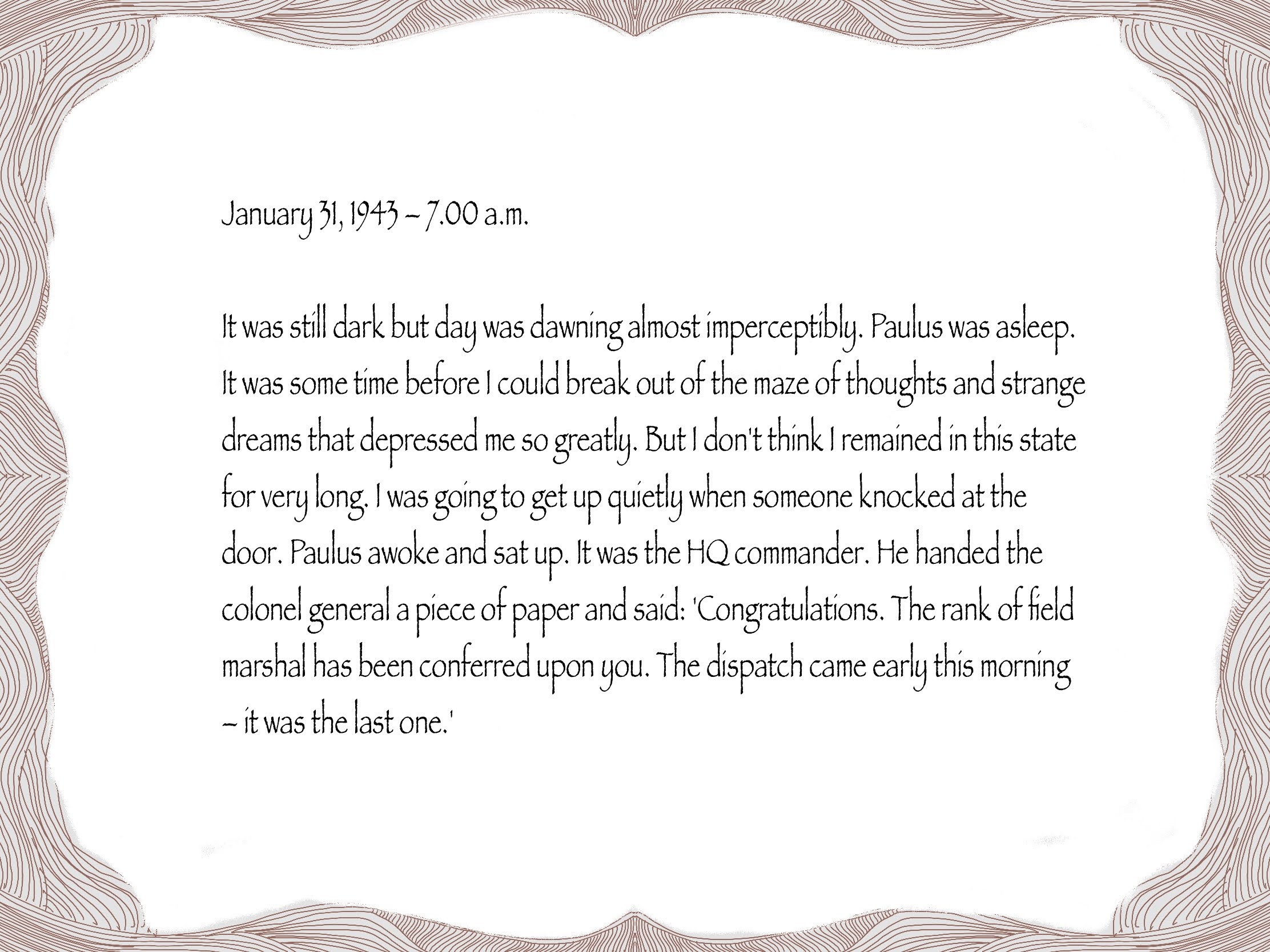
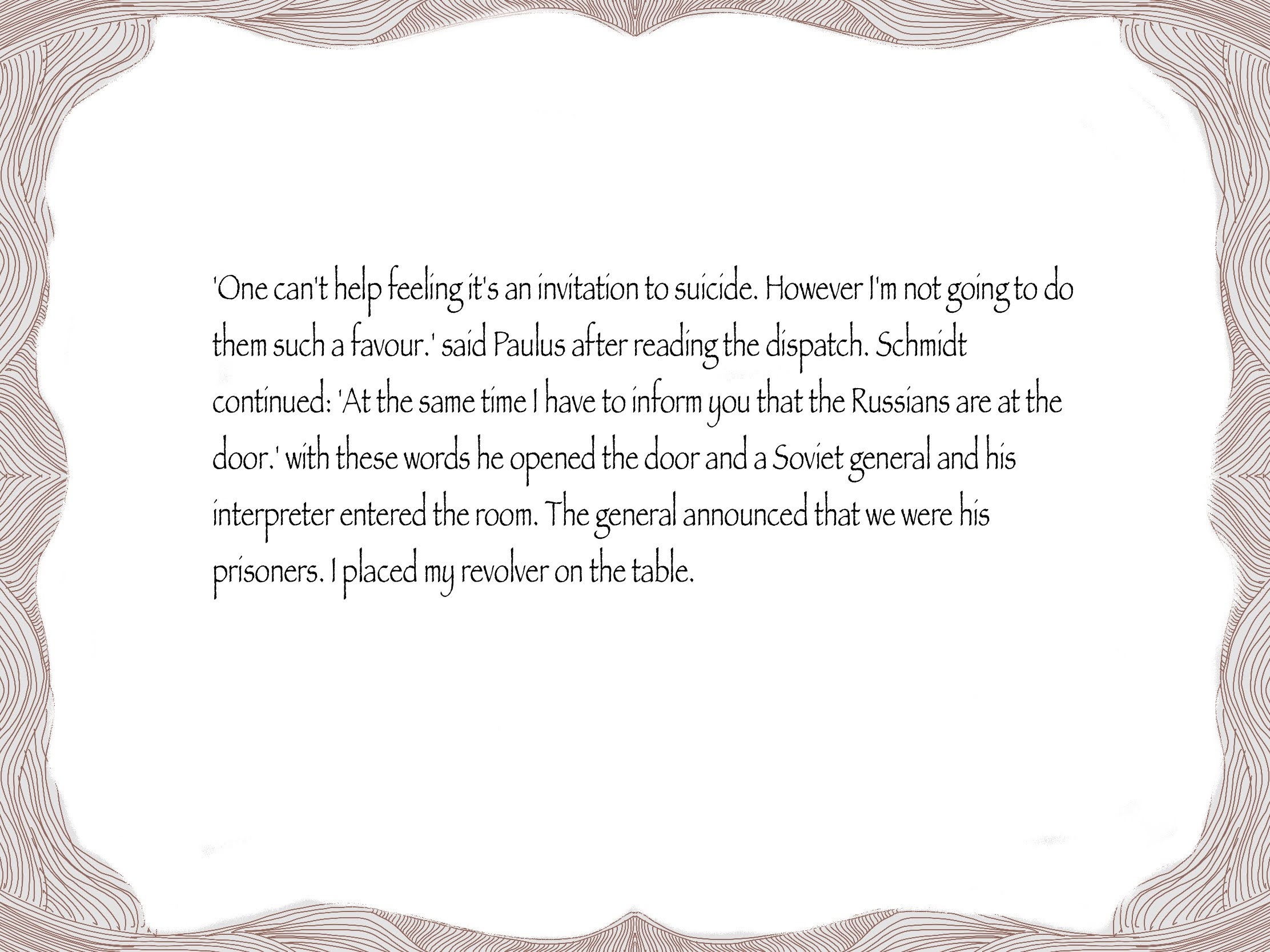
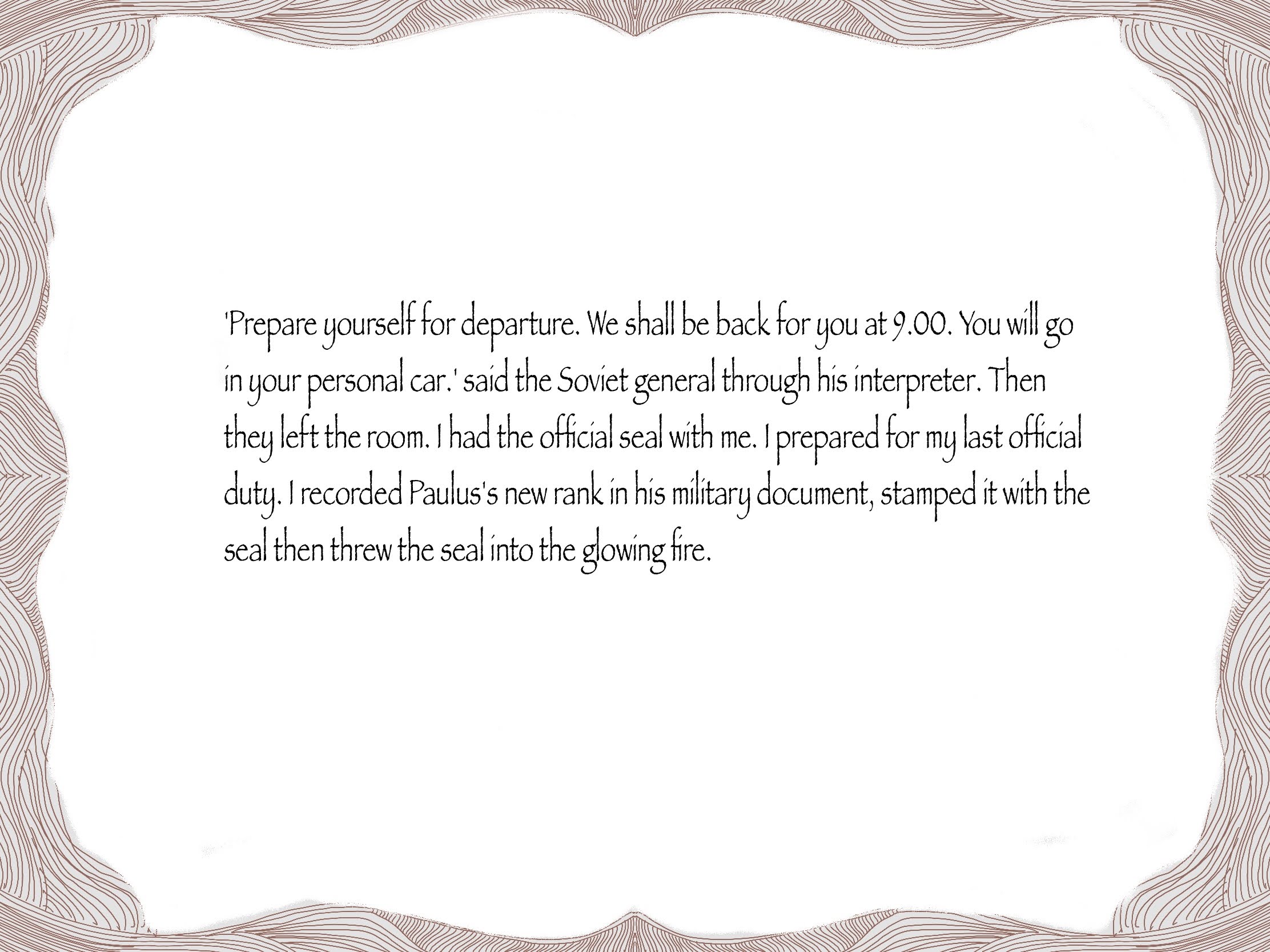

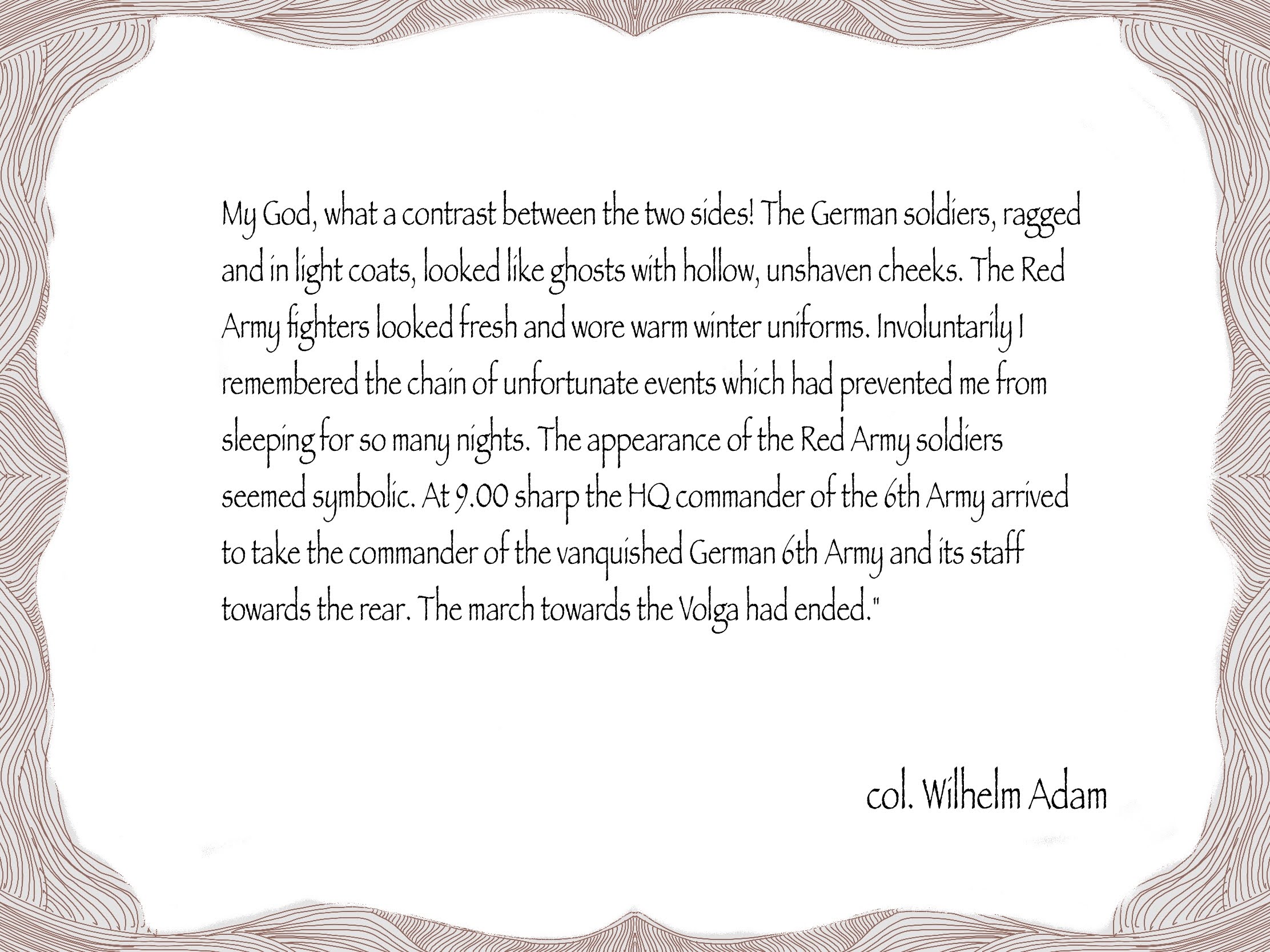
91,000 German prisoners were taken. Of them half had died walking to the Siberian prisons. And nearly half as much as many died in captivity; only about 6,000 survived and returned home. Paulus returned back to Germany in 1953 where he lived for 14 years since his surrender at Stalingrad. He was buried next to his wife, who had died several years before his return.
The battle of Stalingrad was a clear defeat for the Axis powers and a turning point in our history.